

ACCIDENTS: NTSB OPENS DOCKET ON NAPLES CRASH
REGULATION: PRIVACY HAS UNINTENDED REGISTRY EFFECTS
OPERATIONS: GARMIN MAKES CHARTING SMARTER
Special Report: Engine Product Support



ACCIDENTS: NTSB OPENS DOCKET ON NAPLES CRASH
REGULATION: PRIVACY HAS UNINTENDED REGISTRY EFFECTS
OPERATIONS: GARMIN MAKES CHARTING SMARTER
Special Report: Engine Product Support
Flexible, fast, and long-range business jets are the perfect payload platform




12 Special Report: AIN Product Support Survey, Engines
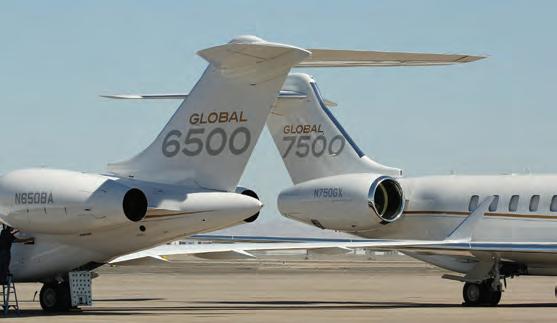
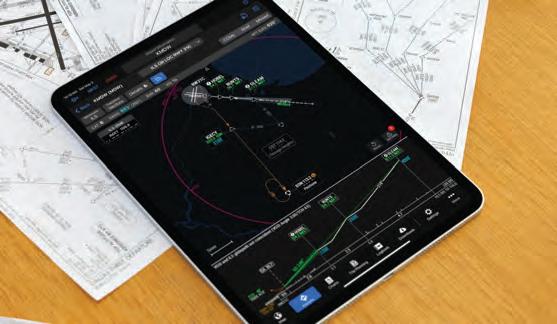
4 Gulfstream delivers first ultra-long-range G800
6 NTSB docket details final moments before 604 crash
8 World Kinect to buy Universal Weather’s trip-support business
10 GAMA: Bizjet deliveries, billings up in first half
22 JetNet sees bizjet deliveries scale up as optimism jumps 24 India’s business aviation blind spot—FBOs 26 AIN Roundtable: The changing world of in-flight connectivity
Product Support: Above & Beyond 40 From pax to AEW&Cs: Business aviation is booming in defense sector


BY CURT EPSTEIN
Following its dual FAA and EASA certification in April, Gulfstream has delivered its first ultra-long-range G800, the Savannah, Georgia OEM said in late August. The first delivered G800 was outfitted at and delivered from the airframer’s completions facility in Appleton, Wisconsin, which is the General Dynamics subsidiary’s largest outside of its Savannah headquarters.
“We have seen astounding demand for the G800, and the entire Gulfstream team is excited to begin making deliveries to our customers,” said company president Mark Burns. “The G800 is entering service with extraordinary program maturity, just like the Gulfstream G700 before it. We look forward to customers around the world experiencing the aircraft’s remarkable capabilities and cabin comfort.”
First announced in late 2021, the largecabin twinjet received the dual certifications after exceeding expectations during performance testing. Its 8,200-nm range at a longrange cruise speed of Mach 0.85 was 200 nm longer than originally projected. The G800 offers a 7,000-nm range at a high-speed cruise of Mach 0.90 and has a maximum operating speed of Mach 0.935. Balanced field length takeoff distance of 5,812 feet (1,771 meters) and a landing distance of 3,105 feet are also shorter than Gulfstream’s projection. This will give its customers access to more airports, the company said.
The aircraft’s interior can be configured in four living zones, or three living zones plus a crew rest compartment. It features 16 of Gulfstream’s trademark oval cabin windows and has a cabin altitude of 2,840 feet when flying at 41,000 feet. z
GE Aerospace and Beta Technologies have begun work to jointly develop a hybridelectric turbogenerator to power various military and civil aircraft. Under the terms of a strategic partnership, GE is making a $300 million equity investment in Beta, which is developing the CX300 and Alia 250 allelectric aircraft. According to the companies, the new hybrid powertrain could be based on existing GE engines, such as the CT7 and T700 turboshafts. They are aiming to deliver improved range, payload, and speed for aircraft that include extended-range VTOL aircraft and new models that Vermontbased Beta might develop in the future.
EASA has approved Dassault’s Falcon 6X for enhanced flight vision system (EFVS) operations based on the manufacturer’s FalconEye head-up display (HUD). The European air safety regulator added the amendment to the large-cabin jet’s type certificate on September 3, allowing operations down to 100 feet above the threshold on Cat 1 approaches. Initially, the approval covers a single HUD configuration. Dassault aims to achieve authorization for a dual HUD setup.
Tamarack Aerospace forged an expanded collaboration with operational and flight-planning software provider ForeFlight to deliver higher-resolution performance data for Active Winglet-equipped Citations. The broadened datasets aim to provide operators with improved accuracy for fuel burn, time en route, and overall performance planning. The rollout of the service begins with Cessna CJ2 and CJ2+ operators, with subsequent phases to include Cessna 525 and 525B-series jets.



BY CHAD TRAUTVETTER, AMY WILDER, MATT THURBER
Hop-A-Jet pilots Edward Murphy and Ian Hofmann had just 75 seconds between the first indication of trouble with their Bombardier Challenger 604’s GE Aviation CF34-3B engines and crash landing the twinjet on I-75 in Naples, Florida, on Feb, 9, 2024, according to a trove of documents released last month by the NTSB.
The first of three master caution warnings—left engine oil pressure—was recorded at 15:09:33 EST, followed by the same for the right engine one second later, and an engine warning six seconds later.
It took the crew an additional 20 seconds, at 15:10:05, to realize both engines stopped producing power while the airplane was at about 1,000 feet msl and 122 knots on a shallow intercept angle for the final approach course to Naples Municipal Airport (KAPF). The crew then transmitted to tower, “…lost both engines…emergency…making an emergency landing.” The tower controller acknowledged the call and cleared the airplane to land.
While at about 900 feet and 115 knots, the crew replied, “We are cleared to land but we
are not going to make the runway…ah…we have lost both engines.”
The twinjet touched down on the southbound lane of I-75 at approximately 15:10:47, when aircraft ADS-B data also ceased. According to a 17-second dashcam video submitted to the NTSB, the airplane initially was in a shallow left turn and then leveled its wings before touchdown, aligned with traffic. It then showed the left main landing gear touching down first in the center of the three lanes and then the right gear touching down in the right lane. Video then shows the airplane continuing through the right-side emergency lane and into the grass shoulder area before hitting a concrete sound barrier. Then the video showed the Challenger obscured by dust, fire, smoke, and debris.
Murphy and Hofman perished in the accident, but the cabin attendant and two passengers escaped with minor injuries. One person on the ground also suffered minor injuries. The air charter—operated under Part 135 by Fort Lauderdale, Florida-based Hop-A-Jet—originated at Ohio State University Airport (KOSU) in Columbus, Ohio, and
Embraer Executive Jets reached a milestone in August with the delivery of its 2,000th business jet. The celebrated aircraft, a midsize Praetor 500, was handed over to an undisclosed corporate flight department from the company’s global customer center in Melbourne, Florida. The OEM delivered its first executive jet—later branded as the large-cabin Legacy 600, a derivative of the ERJ-135 regional jet—in 2002, and then expanded its line with the Legacy 650, Lineage 1000, Phenom 100/300, Legacy 450/500, and Praetor 500/600.
The super-midsize and large ultra-long-range business jet market niches have structural differences in client profiles, needs, and preferences, according to a new report from industry consultancy Rolland Vincent Associates (RVA). The former tends to be more price sensitive and the latter more focused on performance and comfort, it said. These di erences impact aircraft design, product strategy, and investment decisions, RVA found. It predicts the next clean-sheet business jet platform will likely emerge in either the upper end of the super-midsize or within the large-jet class.
The FAA has approved the retrofit of Garmin’s Autoland and Autothrottle systems for Beechcraft King Air 300-series turboprop twins with G1000 NXi avionics, four-bladed propellers, and PT6-60A engines. For select King Air 300s and 350s, Garmin’s Autothrottle will fully integrate with the G1000 NXi cockpit to reduce pilot workload by automatically controlling engine power levels from takeo to landing. The system also provides ITT and torque protection and overspeed and underspeed protection.







Taxiing and maneuvering aircraft on the ground requires the same attentiveness and professionalism that flying them does. Safety depends on every crew playing their part by ensuring their aircraft is always where it’s supposed to be on the airport surface. Listen actively, stay vigilant and act decisively to resolve any doubt regarding controllers’ instructions. Staying sharp on airport signage and surface markings is another key to avoiding incursions and mishaps. The basics your first flight instructor emphasized about maneuvering on an airport remain relevant today, no matter what you fly.
Reinforce standard-operating procedures for your aircraft and organization. Mount this poster where it can serve as a visual reminder to stay vigilant even while on the ground. Need more? Download free copies at usaig.com.

Thank you and safe flying!
Find out more about our coverage, our Performance Vector safety initiative or Performance Vector PLUS good-experience returns program. Contact us and we’ll connect you with an aviation insurance broker in your area.

John Brogan President and CEO, USAIG






































































































































































































































Write down taxi clearance and read back call sign and key elements as a vital crosscheck.
Avoid non-pertinent activities while taxiing; suspend other cockpit tasks when approaching a runway.

























Good airmanship isn’t just about flying – it’s important on the ground before taking off and after landing, too. The basics taught early in every flying career about maneuvering on an airport remain important. In fact, they’re even more vital to avoiding traffic conflicts, runway incursions and collisions at busy multi-use airports. Safety depends on clear communications, each crew knowing where they’re supposed to be, and always being there.
Reference airport diagram during taxi and verbalize intent, e.g., “I’m about to enter Runway 4L.”
Actively confirm position: visual cues, surface markings, signage, compass/runway heading aligned.






























































































was a supplemental lift flight for NetJets.
In interviews with other Hop-A-Jet pilots, Murphy—the accident captain—was recounted as a meticulous planner, with checklist discipline. First officer Hofmann was portrayed as “a very calm individual” who “was there to participate and be involved and to learn and to be an active member of the crew.”
The docket further detailed the harrowing escape of flight attendant Sydney Ann Bosmans and passengers Aaron Baker and Audra Green. Bosmans’ last-minute seat change and her knowledge of how to open the luggage hatch, despite no formal training on how to do so, may have saved lives.
According to the flight attendant’s interview with investigators, she made a critical choice in the final moments of flight. Rather than remaining in the forward-facing jump seat behind the pilots, Bosmans assessed the situation and then moved to the aftfacing seat in the left forward cabin.
Bosmans, who had been trained through Aircare International’s FACTS program, recalled following training protocol as best she could, citing it as a factor in her decision to move. She knew that she’d be in a better position to brace and then to assess conditions outside the aircraft on the ground.
After moving, she instructed the two passengers to brace, grabbing their ankles and positioning their heads correctly while keeping them as calm as possible. She described the impact as “like a slow-motion movie...shit was just flying everywhere,” and the cabin quickly filled with smoke and “neon flames.”
After the impact, Bosmans moved first to the forward cabin door but was unable to open it. Acutely aware of the danger of smoke inhalation and the threat of fire, she quickly turned to the overwing exit, where the interior panel had already been removed. Bosmans was unable to open that door either, later noting, “The flames were actually coming up on that side...it probably would have been a lot worse if I got that door open.”
That left one remaining option: the baggage compartment door at the rear of the aircraft. Bosmans headed aft, where she found Green asking for help and Baker already attempting to access the area. “He was kind of leaning out the baggage door, so I’m assuming that he was trying to get out that way already,” she said.
In near-complete darkness and with thick smoke filling the cabin, Bosmans attempted to operate the internal latch on the door. “I grabbed the lever on the door...pulled it inward...and I can’t get it,” she recalled. “This door is blocked and stuck.”
With the compartment cluttered by luggage and no flashlight, she coordinated with Baker and Green to remove obstacles.
“I started handing Aaron stuff, and I’m assuming he was handing Audra the stuff as well.”
Then came a sound she couldn’t explain. “I heard like a bang on the door...it’s super close to my face. And I truly thought in that moment that there was another person on the other side of the door...obviously, there was no one there, but at the time, like, that’s what I truly believed, and it kind of gave me that…I know I can get this door open.”
She continued handing items back until she was able to clear space to open the hatch. Bosmans recalled that she was first to exit, with flames “coming underneath” her. After a delay in which she thought they might be retrieving belongings, the passengers followed. Bosmans urged them to stay together and move away from the wreckage.
Bosmans had not received formal training on the use of the baggage compartment door. “We don’t get trained to open the baggage door. I actually just knew how to do that...I would kind of do it as a favor to the pilots,” she told investigators.
On the mechanical side, the NTSB documented a hung start problem in the engines of the doomed Challenger 604 based on an interview with Hop-A-Jet pilot Anthony Donato, who is also an A&P mechanic with
inspection authorization, and analysis of historical data.
A preliminary report confirmed the flight crew reported low oil pressure before the dual engine failure.
According to the NTSB docket, 25 days prior to the accident, “a series of hung engine starts were recorded by the FDR [flight data recorder]. There were 10 hung starts in total between the two engines, with one successful start on engine 1 occurring during these start attempts.”
The NTSB explained, “A hung start, also known as a hot start or stagnated start, is defined as a start attempt that experiences a light off but does not then successfully continue to a self-sustaining idle speed before engine ITT [interstage turbine temperature] exceeds the start redline. Hung starts may be caused by a variety of factors, including weak starter performance, premature starter deactivation, a degraded or damaged compressor, incorrect scheduling of bleeds or compressor variable geometry, or bad fuel.”
Comparing the hung starts to FDR data from the accident, the NTSB wrote, “the engines’ fuel and ITT behavior during the event flight was consistent with the behavior of the engines during the hung start rollbacks.”
During the interview with NTSB investigators, Donato said he believed hung starts in the Challenger was an extremely abnormal issue.
“Out of the 12,000-plus hours in the Challengers [that he had logged], from time to time, you might get a hung start. By the time you go back, the other one starts up. This here was…the right engine would never start after I don’t know how many attempts, and the left engine, it took, oh, gosh, I don’t know, three, four attempts.
“Finally, it got started and…we’re thinking, all right, maybe it’s a bleed issue, so let’s try to do a cross-bleed with the operating engine…we still couldn’t get the right engine going. So that was a telltale sign to me saying this is extremely abnormal.” z
BY CURT EPSTEIN
World Kinect, the parent company of World Fuel Services, announced a blockbuster acquisition in September with an agreement to purchase Universal Weather and Aviation’s trip support services (TSS) division. According to the company, the deal—expected to close by year-end—is worth approximately $220 million and will include the Universal Weather and Aviation brand name, as well as the agreements Universal has made with third-party ground handlers around the world.
“We’re excited to announce the agreement to acquire Universal Weather’s TSS division, which will significantly expand our trip support services business,” said World Kinect COO John Rau. “This strategic move complements our fuel business and enhances our ability to deliver comprehensive flight operations support—including flight planning, overflight permits, and ground support services—at more than 3,000 airports worldwide.”
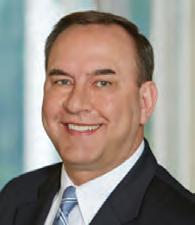
The sale of its trip support division leaves Universal with Universal Aviation, its worldwide FBO and ground-handling supervisory network, as well as the Air Culinaire in-flight catering business.
Rau added that World looks forward to welcoming Universal’s TSS team in the move, which will bring immediate value to World’s customers. The transaction is expected to be completed in 60 to 90 days, meaning the two companies will still exhibit as separate entities at NBAA-BACE in October. z

Key industry metrics such as flight activity, backlogs, deliveries, and preowned transactions all increased in the first half of the year despite uncertainties around ongoing trade discussions, according to Global Jet Capital’s (GJC) second-quarter Business Aviation Market Brief. The report notes, “Growth in Q2 2025 proved resilient, and the outlook for steady growth going forward has improved.” In the quarter, business jet flight operations ticked up 3.1%, while OEM backlogs increased by 8.4% year over year. Preowned transactions also were up from a year ago.
Saudi Arabia’s General Authority of Civil Aviation (GACA) has approved VistaJet to o er charter flights in the country under its private flight membership programs. It is the first foreign operator to get the go-ahead for commercial flights since GACA abolished cabotage flight restrictions for air charter operators in Saudi Arabia five months ago. Dubai-based VistaJet plans to o er its ultra-long-range Bombardier Global 7500 for flights in Saudi Arabia and for intercontinental trips.
FlightSafety International is constructing a 100,000-sq-ft learning center in Mesa, Arizona. The move will expand the company’s flight crew and maintenance technician training operations as it responds to increasing demand for aviation education services. Scheduled to break ground this month and open in early 2028, the facility will house fullflight simulators and advanced training devices for pilots, maintenance technicians, and cabin crews. The center represents FlightSafety’s second Arizona location, complementing its existing Tucson learning center.
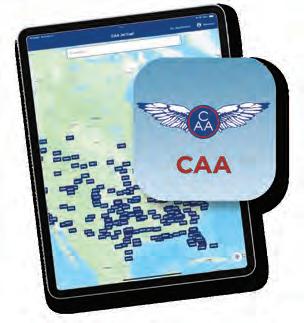
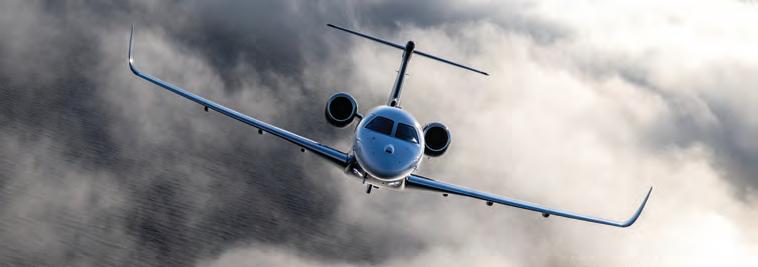
BY CURT EPSTEIN
Business jet deliveries rose by nearly 10% in the first half of the year versus the same period in 2024, according to the latest quarterly delivery report from the General Aviation Manufacturers Association (GAMA). OEMs handed over 354 business jets through the first six months compared with 322 a year ago, contributing to a more than $1 billion increase in aircraft billings, to $12.3 billion for the period.
All of the major business jet OEMs either saw improvement or equaled their performance from last year. Embraer saw the largest year-over-year (YOY) increase—36%—delivering 61 business jets in the first half. The Brazilian manufacturer has focused on evening out its production across the entire year rather than backloading it towards the end.
Gulfstream also saw a significant YOY gain, with the Savannah airframer handing over 13 more jets in the first six months, including 10 additional large-cabin jets. Textron Aviation improved on its first-half 2024 total by two Cessna Citations for a total of 80 deliveries in the first half of this year. Bombardier remained static, with 59 deliveries in the first half of both years. Dassault, which only reports twice a year, delivered 12 Falcon jets in the first half of the
year, as it did during the same span in 2024. The turboprop segment overall saw a 4.3% decrease in deliveries YOY. Due to the continuing ramp-up in its new flagship M700 Fury, Piper saw a 61% improvement across its turboprop deliveries. Textron remained static among turboprops, with 64 deliveries in the first half of both years. Daher delivered five fewer aircraft this year than it did in the first half of 2024, while normally consistent Pilatus logged six fewer PC-12 deliveries this year than it did in the two quarters a year ago.
Rotorcraft deliveries for the first half of the year saw minor erosion, with the turbinepowered segment faring slightly worse, down 2.3% from a year ago. Despite that, billings for the rotorcraft segment rose by 20% to $2 billion. The decrease was driven largely by Robinson Helicopter’s R66, with deliveries off by 40% YOY. The Torrance, California OEM handed over 39 of the single-engine R-66 in the first six months of this year, compared with 65 in the same span last year.
On the other hand, Textron subsidiary Bell had a 20% increase compared with the first half of 2024, and Airbus Helicopters delivered six more units this year than it did in the first six months of 2024. Italy-based Leonardo had four fewer deliveries this year than it did in first half 2024. z
Spike Aerospace is refining the aerodynamics, cabin configuration, and lower-boom performance of its Mach 1.6 S-512 Diplomat as it lays the groundwork to bring a supersonic business jet to market. The Atlanta-based company is completing what it calls an “enhanced study” that builds on previous research and design iterations to validate its ability to meet stringent noise requirements over land. It plans to develop an 18-passenger supersonic jet that can link London and Dubai in about 3.2 hours.
Elliott Aviation has partnered with Prizm Aircraft Lighting to introduce the Starlight Cabin Headliner, a feature that projects customizable constellations onto an aircraft cabin ceiling. Integrated into the Prizm full-spectrum lighting system, the headliner can display actual or custom star patterns, adjustable through the Prizm app. The first installation was completed on a Bombardier Challenger 300.
Wheels Up has sold three subsidiaries— Baines Simmons Safety Services, Kenyon Emergency Services, and Redline Assured Security—to TrustFlight. This transaction will yield approximately $20 million that Wheels Up will reinvest in fleet modernization and use for general corporate purposes. The sale is part of a wider e ort to streamline the group’s business. TrustFlight—which provides software and data to clients across the aviation sector, including aircraft operators, airports, MRO organizations, and regulators—said the acquisition will expand its portfolio to cover training and regulatory expertise, aviation security and quality assurance, and critical incident support.

The purpose of a business aircraft is to facilitate quick, efficient transportation, and Part 3 of AIN ’s annual Product Support Survey deals with the system that powers that value proposition: engines.
Our readers provided feedback on the support their aircraft powerplants— whether turbofan, turboprop, or turboshaft—received from their respective manufacturers. In this year’s results, GE Aerospace retained its top position for jet engines with an overall average score of 8.81, despite changes to the AIN survey methodology this year that weighted more toward independent reviews.
BY CURT EPSTEIN
The highest-rated turbofan engines this year were GE’s Passport (9.20), followed by Williams International’s FJ44 (8.77) and Rolls-Royce’s Tay (8.69).
In the turboprop arena, Pratt & Whitney Canada surpassed Honeywell this year, garnering an overall average of 8.42. Its PT6 engine family received the highest mark (9.54) among all powerplants in overall engine reliability, and the Montreal-based manufacturer also topped the turboshaft category with an overall average of 8.19.
The engine makers continued the narrative heard across the other two parts of the Product Support Survey,
describing some hurdles in the industry.
“Industry-wide challenges, including supply chain pressures, continue to affect turnaround times and the availability of engine parts across all OEMs,” Anthony Rossi, Pratt & Whitney Canada’s v-p of customer service, told AIN. “However, we are seeing signs of improvement on the overall capacity and the flow steadiness.”
Other factors also are at play. “Labor availability remains a focus across the entire aviation industry, and Rolls-Royce is proactively addressing it,” said Lindsey Stuss Gillen, the company’s v-p of sales and marketing for business aviation. z
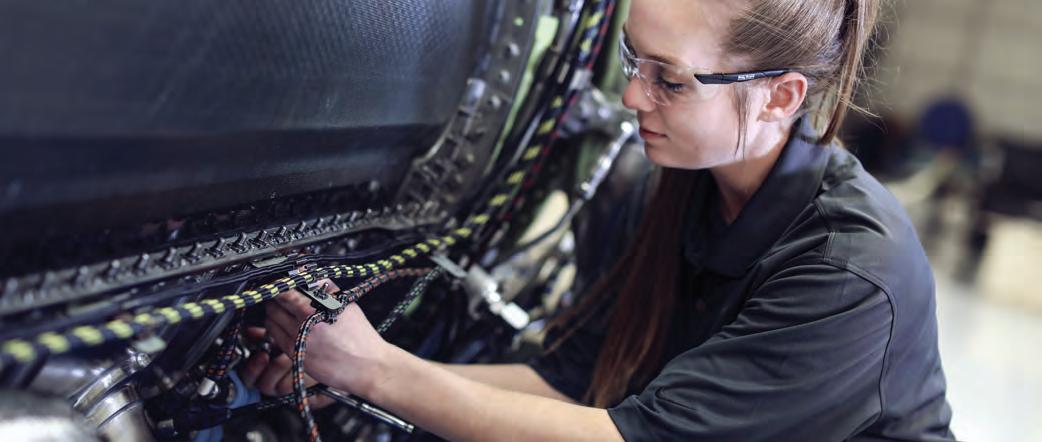
Repeating its position at the top of the AIN Product Support Survey: Engines chart for this year, with an overall average score of 8.81, is GE Aerospace, which recently celebrated its first anniversary as a standalone company. It edged out the second-place
finisher by three one-hundredths of a point. The manufacturer—which produces the CF34 and Passport engine families— led in five of the eight survey categories and finished second in AOG response (8.81) and overall engine reliability (9.40).
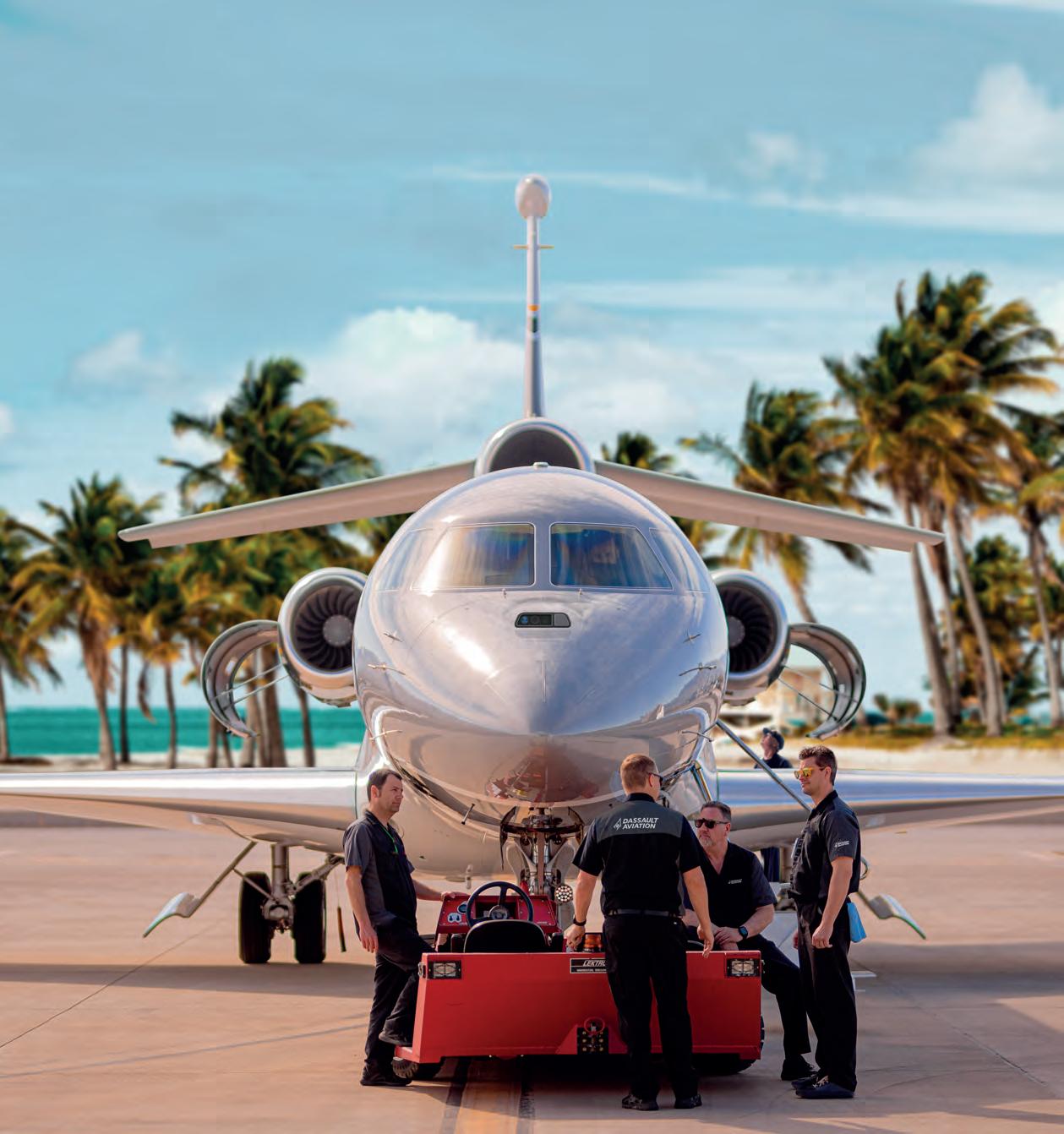




AIN ’s annual Product Support Survey aims to quantify and rate through statistical analysis the product support functions of business aviation manufacturers over the past year. The survey, whose respondents include operators of business jets, pressurized turboprops, and turbine-powered helicopters, endeavors to encourage continuous improvement in airframe, avionics, and engine product support throughout the industry.
For the third year, AIN conducted the survey via a questionnaire developed in partnership with Rolland Vincent Associates, a Texas-based consultancy focused on aviation market research, strategy, and forecasting. Designed to provide improved ease of use and to encourage more participants to complete the entire questionnaire, the English-language survey tool includes clear language and imagery around the categories and evaluation scale. Finally, it asked respondents to evaluate one full aircraft at a time, including airframe, engines, and avionics.
AIN emailed qualified readers a link to the password-protected survey website active from late April to mid-June. It asked respondents to rate individual aircraft and provide the tail number, aircraft age, and primary region of service. The survey also asked respondents to rate, on a scale from 1 to 10, the quality of service they received during the previous 12 months in the following engine categories: Factory-owned Service Centers; Authorized Service Centers; Cost Per Hour Program; Parts Availability; Cost of Parts; AOG Response; Warranty Fulfillment; Technical Manuals; Technical Reps; and Overall Engine Reliability.
In total, 948 unique respondents, representing 1,863 aircraft, from 62 countries completed the survey. While above last year’s total, AIN did not receive enough responses to verifiably report on all manufacturers in all categories and on several engine models. Rolland Vincent Associates reviewed the data to ensure
accurate and valid responses. It also compiled the final survey results in close coordination with AIN
AIN ’s analysis of the survey showed that scores slightly improved this year despite several challenges faced by product support organizations:
» Flight hours remained elevated between the May 2024 to May 2025 survey period and flying exceeded pre-pandemic levels in all business aviation segments. More flying leads to more unscheduled maintenance and demand on support teams.
» Supply chain disruptions created longer lead times for parts acquisition but these are finally showing signs of easing.
AIN’s 2026 Product Support Survey will be conducted from late April to mid-June next year. Recognition of personnel who went Above & Beyond on behalf of their customers follow this article.

Featuring the Garmin G3000 ® PRIME with the largest touchscreen displays in its class, professional has been redefined – introducing the brand-new PC-12 PRO.
It was also among the top in warranty fulfillment at 9.15 and at the top with factory owned service centers with its second strongest score (9.38) behind overall engine reliability,
This year, the company will reach a milestone with the delivery of its 500th Passport engine, which powers Bombardier’s top-of-the-line Global 7500 and 8000, expected from its Lafayette, Indiana production facility by the end of the year. Introduced in 2018, the Passport fleet recently surpassed 600,000 flight hours, with a 99.9% dispatch reliability.
Passport operators gave the engine the highest overall average, putting it at the top of the chart in seven individual engine categories: Factory owned service centers (9.61), authorized service centers (9.56), cost per hour programs (8.65), cost of parts (8.89), AOG response (9.45), technical representatives (9.38), and technical manuals (9.26).
The company’s CF34 family—as used on Bombardier’s Challenger 600 series—received an overall average score of 8.39 and tied for the high score in the overall engine reliability category with a 9.49.
To support its business aviation products, GE Aerospace’s OnPoint Service program was established with the belief that only an OEM can have a comprehensive understanding of its products, and the program provides concierge-level service to its customers. Aside from events such as foreign object damage, which are not traditionally covered by programs, OnPoint
covers all parts, labor, shop visits, line-replaceable units, lease pool engines, and all transportation for loaner engines. The process involves one call, and the company’s field service technicians handle the work from diagnostics to completion.
That service gave GE Aerospace the top score among engine makers in the cost per hour programs category (8.55). It also led in technical manuals (8.79) and technical representatives (8.85), in addition to its strong warranty fulfillment score. Even in cost of parts—a category that dragged the scores of its competitors—GE Aerospace was the only OEM to score higher than an 8.0 (8.14).
The company continues to expand its use of AI-enabled digital solutions to improve the ability of its fleet support team and MRO networks to predictively monitor and service its engines. According to Melvyn Heard, GE Aerospace’s general manager for business aviation, it is seeing 60% earlier lead times in identifying predictive maintenance recommendations, and this has also enabled it to monitor more engine conditions over time.
“Our overall approach to product support is rooted in our commitment to continuous improvement,” Heard told AIN.
Another area where GE Aerospace is seeing growth is in its FlightPulse electronic flight bag application, which has had more than a 150% rise over the past three years to more than 60,000 users. Developed by its software-as-a-service team, it gives pilots safety and fuel insights based not only on their own flight data, but also from safety information across the industry.
Rising up one position from last year to second place with an overall average score of 8.78 in the AIN Product Support Survey is Williams International. The company, which is based in Pontiac, Michigan, and was founded in 1955, specializes in powerplants for a wide range of smaller-class jets, including the Cessna CJ4, Pilatus PC-24, and Cirrus Vision Jet SF50.
More than 8,200 FJ44 and FJ33 family engines are in service and have accumulated over 21 million hours in flight, and the manufacturer noted that it remains relentless in its pursuit to deliver the industry’s best product support.
“As our fleet expands, our commitment to top-notch support grows stronger,” said Steve Shettler, Williams’ senior v-p of commercial programs and product support. “Our recent focus zeros in on rapid hardware availability and

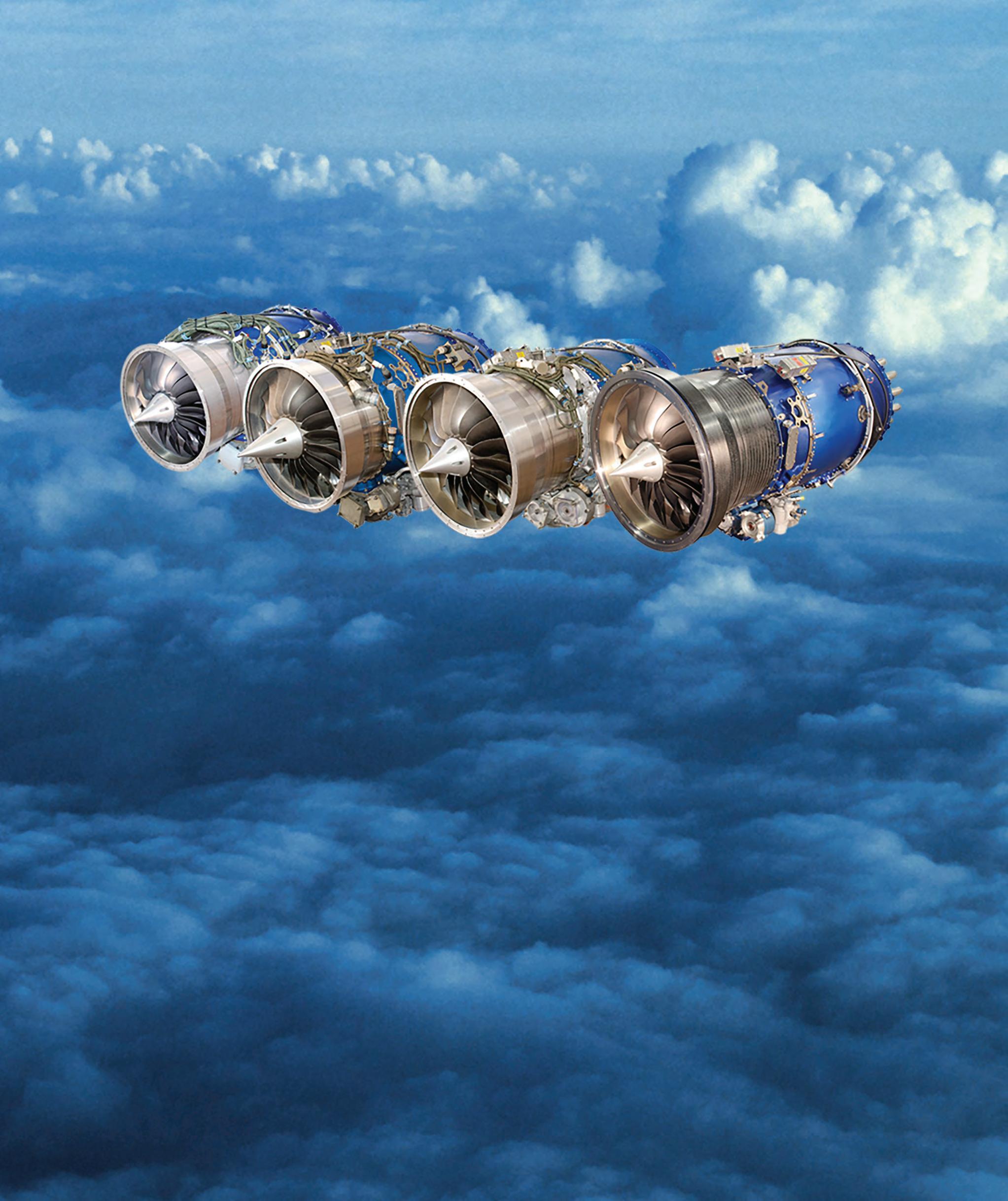
efficient positioning, making service accessible and as quick as possible.” That strategy appears to have registered with AIN ’s readers, who gave the company the highest score among engine OEMs this year in AOG response (9.09), as well as an 8.89 in the parts availability category.
Shettler told AIN that expanding its maintenance capabilities is also a priority. “We have nearly completed upgrading all service centers to full line service status, empowering them with enhanced capabilities to further reduce downtime for our operators,” he added. Williams expects to have all the remaining authorized service centers reach that plateau in the near future.
In terms of cost per hour programs, Williams tallied secondhighest in the category among jet engine producers, with a 7.70 score from our survey respondents. Shettler said that the OEM’s Total Assurance Program (TAP Blue) engine maintenance plan offers coverage no competitors can match, even including repair of foreign object damage and incorporation of all service bulletins. “Enrolling in our TAP Blue program means owners and operators can enjoy worry-free maintenance done at authorized service facilities, with costs covered by the program,” he said, adding that the program is a “guarantee of the highest quality maintenance performed by highly skilled and trained technicians through approved service centers.”








































Connectivity is shaping the future of aviation. It is a future where aircraft, air traffic control, pilots and passengers are constantly connected to enhance safety, improve operational performance and create breakthrough experiences.


Aviation connectivity has come a long way since 1912, when Britain’s Royal Flying Corps installed a telegraph system on a pre-World War I biplane, allowing pilots and ground crews to communicate. Onboard radios were next, and they became the primary means of air-to-ground and air-to-air communications for 75 years until satellite communications (satcom) systems entered the picture.
Satcom revolutionized connectivity by enabling continuous communication beyond visual line-of-sight (BVLOS). Satcom really took off in the 1990s thanks to new satellite constellations, regulatory changes and innovations in hardware and software.
High-speed broadband satcom arrived in the mid-2010s, ushering in a new age of connectivity that emphasized speed, expanded coverage and consistency.
Breakthrough innovations in avionics, sensors, microprocessors and satcom have created a new generation of highly connected, intelligent aircraft capable of real-time data exchange and autonomous decision-making.
Today’s aircraft are considerably more advanced than the global air traffic management (ATM) ecosystem in which they must operate. The ATM system has limited capacity to manage the volume, complexity and diversity of modern aircraft.
If anything, the challenges facing ATM will become more severe in the years ahead as passenger and cargo traffic grows1 and next-generation advanced air mobility (AAM) aircraft come into play.
Learn more about the future of connectivity























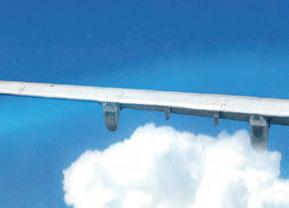
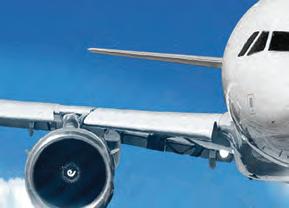














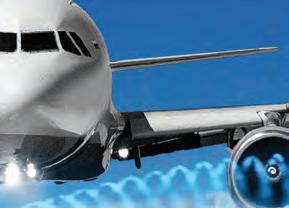



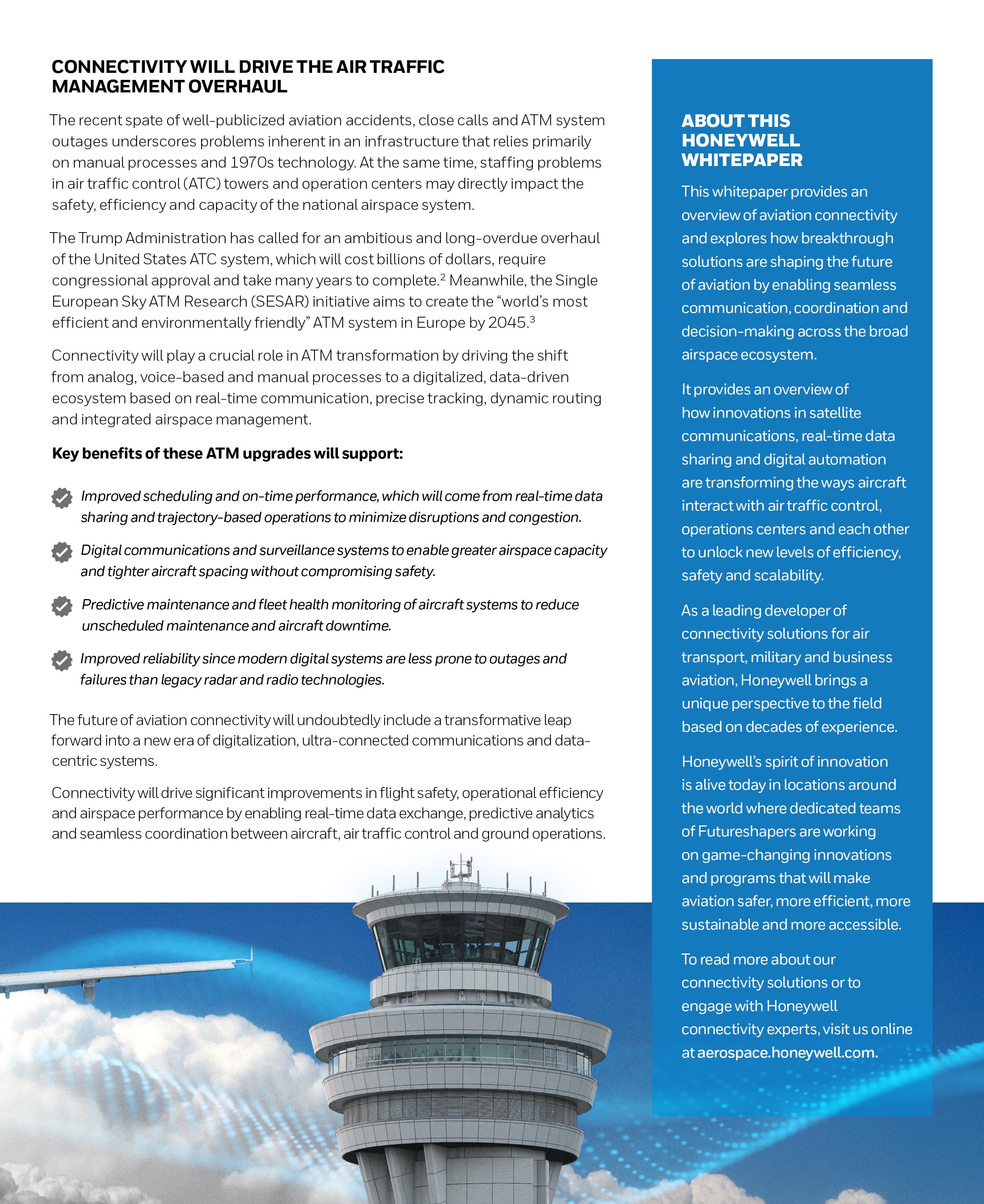










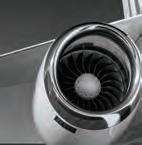
Connectivity is at an inflection point once again. New satellite constellations on the horizon will transform the way aircraft connect, communicate and operate within the global ecosystem. Satellite operators like SpaceX, Telesat, Iridium NEXT, OneWeb and Amazon Kuiper plan to launch as many as 70,000 low Earth orbit (LEO) satellites between 2025 and 2031, with thousands dedicated solely to meeting aviation’s expanding connectivity needs.
These vast LEO constellations will complement new and existing medium Earth orbit (MEO), highly elliptical orbit (HEO) and geostationary Earth orbit (GEO) satellite networks. LEO satellites orbit much closer to Earth than MEO, HEO or GEO satellites, so they deliver high-speed connectivity with lower latency. Satellite like








Aviation connectivity involves so much more than a pilot talking to an air traffic controller or a passenger live streaming video in the cabin.

Connectivity enables the seamless exchange of vast amounts of real-time data to aid decision-making, improve safety, enhance operations and create a better experience for flight crews and passengers.”
Jason Wissink President Services & Connectivity







































Honeywell Aerospace



Technologies






Rolls-Royce landed in third place with an overall average score of 8.43 for turbofans. Known for producing the BR700/Pearl families that drive top end business jets such as Gulfstream’s and Bombardier’s large-cabin models, and Dassault Falcon’s under-development 10X, as well as the Tay that powers legacy Gulfstreams such as the GIV and G450, the manufacturer earned its highest category score, as well as the top score among jet engine manufacturers in the overall engine reliability category (9.44), buoyed by the BR700 series share of the category’s top engine score (9.49). The Tay led all engine lines in warranty fulfillment with a near-perfect score of 9.83.
“Over the past year, Rolls-Royce has advanced product and customer support through targeted investments in our dedicated business aviation support network that directly address what our operators value most: unmatched aircraft availability, speed of service, and world-class customer support,” said Lindsey Stuss Gillen, the powerplant maker’s v-p of sales and marketing for business aviation. “We are constantly

listening to our customers—what they want drives what we do. “Rolls-Royce has invested over a billion dollars in its global services network to ensure unmatched parts availability and rapid response worldwide,” Gillen told AIN. “We have never experienced an AOG due to a lack of spare parts or lease engines.”
Prolific engine manufacturer Pratt & Whitney is celebrating its centennial anniversary this year. It is well represented in AIN’s Product Support Survey: Engines, with listings in three separate markets: turbofans, turboprops, and turboshafts. Pratt & Whitney Canada (P&WC), the RTX subsidiary’s general aviation engine division, is based in Longueuil, Quebec, near Montreal, and produces the company’s smaller products.
P&WC engines power a wide span of business jets ranging from the Embraer Phenom 300 to the Cessna Latitude, to the Dassault Falcon 8X, and they earned the manufacturer and overall average in 2025 of 8.01. Its highest score came in the overall engine reliability category with an 8.88, aided by the PW500 (9.37) and the PW300 (8.53).
In an effort to bolster its AOG response, which earned a 7.67 from AIN’s readers this year, the company strengthened its worldwide mobile repair team network, improving responsiveness and coverage for operators across regions.
“We are making major strides in our Zero TSO exchange program, which provides customers with access to freshly overhauled engines at zero time since overhaul,” said Anthony Rossi, P&WC’s v-p of customer service. “This
unlocks faster, more flexible solutions by removing the wait associated with traditional overhauls.” He noted that customers are responding enthusiastically to the speed and simplicity of the exchange concept—exchanging engines as opposed to overhauling them—and the company is increasingly introducing them into both new and existing support agreements. “Engine exchanges are a one-and-done option for customers, offering a single removal and installation, which helps reduce

downtime and simplifies logistics, while eliminating the need for a rental engine,” Rossi told AIN.
Lastly, P&WC introduced a TBO extension on the PW306D1 as used on the Citation Latitude, increasing intervals from 6,000 hours to 8,000 hours to maximize engine availability and reduce operating costs.
Meanwhile, among turboprops, P&WC’s venerable PT6 family earned the highest score among engine makers in the overall
engine reliability category with a 9.53. High scores include 8.95 for technical manuals and 8.96 for warranty fulfillment.
Among the makers of helicopter powerplants, only Pratt & Whitney Canada received enough ratings to qualify for this year’s AIN Product Support Survey and brought in a turboshaft overall average score of 8.19. For overall engine reliability, our readers gave it a score of 9.14, along with an 8.09 in AOG response, 8.66 for technical reps, and a 7.51 in the parts availability categories.
Through the various acquisitions and mergers over its history, Honeywell traces its roots in aerospace back more than 100 years. The TFE731 engine recently celebrated its 50th anniversary, and Honeywell’s HTF7000 family entered service in 2004. In the ensuing 20-plus years, it has equipped a wide range of midsize and super-midsize business jets from a variety of airframers, including the Bombardier Challenger 300 series, Cessna’s Citation Longitude, the Embraer Legacy 450/500 and Praetor 500/600, and the Gulfstream G280. While Honeywell garnered an overall average score of 7.57 in turbofans, its HTF7000 authorized service center network received a high score of 9.29 among engine lines in this year’s survey.
The company’s engine division, which is preparing to be spun off next year as part of Phoenix-based Honeywell Aerospace Technologies, received the highest score for jet engines in the authorized service center category in this year’s survey (8.93).
Over the past year, the manufacturer introduced Honeywell Ensemble, an AI-based enhancement to its Maintenance Service Plan (MSP) program, and installed it on its first HTF engine to provide proactive monitoring of engine health. According to the company, Ensemble simplifies MSP usage, provides enhanced engine performance insights, improves aircraft uptime, and helps operators avoid unexpected maintenance downtime. “Ensemble eliminates the need for operators to manually download and send data to Honeywell,” said Kyle Grzywacz, Honeywell Aerospace Technologies’ general manager for engines. “[It] monitors engine conditions in almost real time and automatically downloads and transmits the data after every flight, which makes it easy for maintenance teams

to detect, analyze, and proactively address potential issues.”
At its Phoenix maintenance center, Honeywell is increasing repair capabilities to improve product flow lines and double its capacity, Grzywacz told AIN. To further lessen aircraft downtime, Honeywell has added 40 rental engines.
Honeywell’s TPE331 turboprop engine was originally designed by Garrett AiResearch in the late 1950s. It has seen dozens of variants and upgrades over its nearly 70 years of service and powers legacy aircraft such as the Mitsubishi MU-2, Beechcraft King Air B100, and Rockwell Turbo Commander. While Honeywell continues to manufacture and service the TPE331 to support them, it is no longer offered as a factory-delivered engine on a new business turboprop. But on the support front, the manufacturer’s turboprop segment received the overall highest score in the authorized service center category (9.13). z


With business aircraft OEM backlogs stabilizing at $55 billion and market optimism taking a sharp upturn in the third quarter, the latest JetNet iQ market forecast significantly scales up expectations over the next 10 years, projecting 9,700 aircraft valued at $335 billion will be delivered through 2034. This compares with a year ago, when the company had forecast shipments of 8,644 business jets valued at $262 billion through 2033.
Releasing its 10-year forecast and third-quarter survey results at the 2025 JetNet iQ Summit in Washington, D.C, in September, JetNet iQ creator Rolland Vincent said, “We’re looking at a $55 billion backlog, and that’s a couple of years of work. Do we have a demand problem in our industry? No. We have a supply problem. We have a workforce problem. But these are what we call good problems.”
JetNet anticipates large, ultra-long-range jets will represent nearly half—49.4%—of the dollar value but yet 22.5% of the delivery volume. In terms of deliveries, light jets will take 19.5% market share, followed by super-midsize jets at 17.1%. Even so, most of the backlog growth in recent years has come in the midsize and light end, Vincent said. Overall, the business jet fleet is anticipated to grow at a compound annual growth rate (CAGR) of 2.15% over the next 10 years, reaching 30,400 by 2035.
On the turboprop side, the forecast is more muted with an expected CAGR of 0.28% and deliveries of 4,100, 88.5% of which will be single- engine models, through 2034. Dollar volume will reach $24 billion.
For 2025, JetNet anticipates 825 new business jet deliveries, up 8% year over year, and 365 new turboprops, down 5%— supply-chain dependent.
BY KERRY LYNCH

This comes as the OEMs are sustaining about a two-year backlog with supplychain constraints, slow certifications, and labor shortages hindering a scale-up in production. For that reason, JetNet believes deliveries will increase more toward the back half of the forecast.
It also follows the recent passage of 100% expensing for business aircraft—the so-called bonus depreciation—with the latest iQ survey revealing that more than half of the respondents said the return of the tax change would increase the likelihood of purchasing a new aircraft in the next 12 months.
As far as overall sentiment, in the second quarter, 51.9% of respondents were pessimistic about the current market conditions for business aviation, while only 34.4% believed the market was past the low point; this represented a net optimism of -17.5%.
In Q3, however, net optimism jumped to +28.4% with 57.9% of respondents now saying the market is past the low point and 29.5% still believing it is on the downturn. The net optimism metric was at the
highest level since the third quarter of 2022.
“We are seeing several key indicators pointing to the health of the market— customer sentiment, preowned jet sales year to date, flying aircraft, order backlogs, book-to-bills, and improved aircraft purchase intent, albeit the latter still at a somewhat subdued level,” Vincent said.
Despite the bullish business aviation market outlook, JetNet cautions that economic growth has moderated in most key markets and geopolitical risks remain high. Further, tari ff uncertainties remain problematic.
“We thought we were going to head to a transatlantic war just after the immediate effects of the tariff announcements came in, and that didn’t happen,” he said. “That’s good. But we do have a lot of geopolitical risks.”
Even so, the underlying sentiment remains strong with 64.1% of survey takers strongly agreeing that without business aviation, their organization would be less successful and less profitable. z
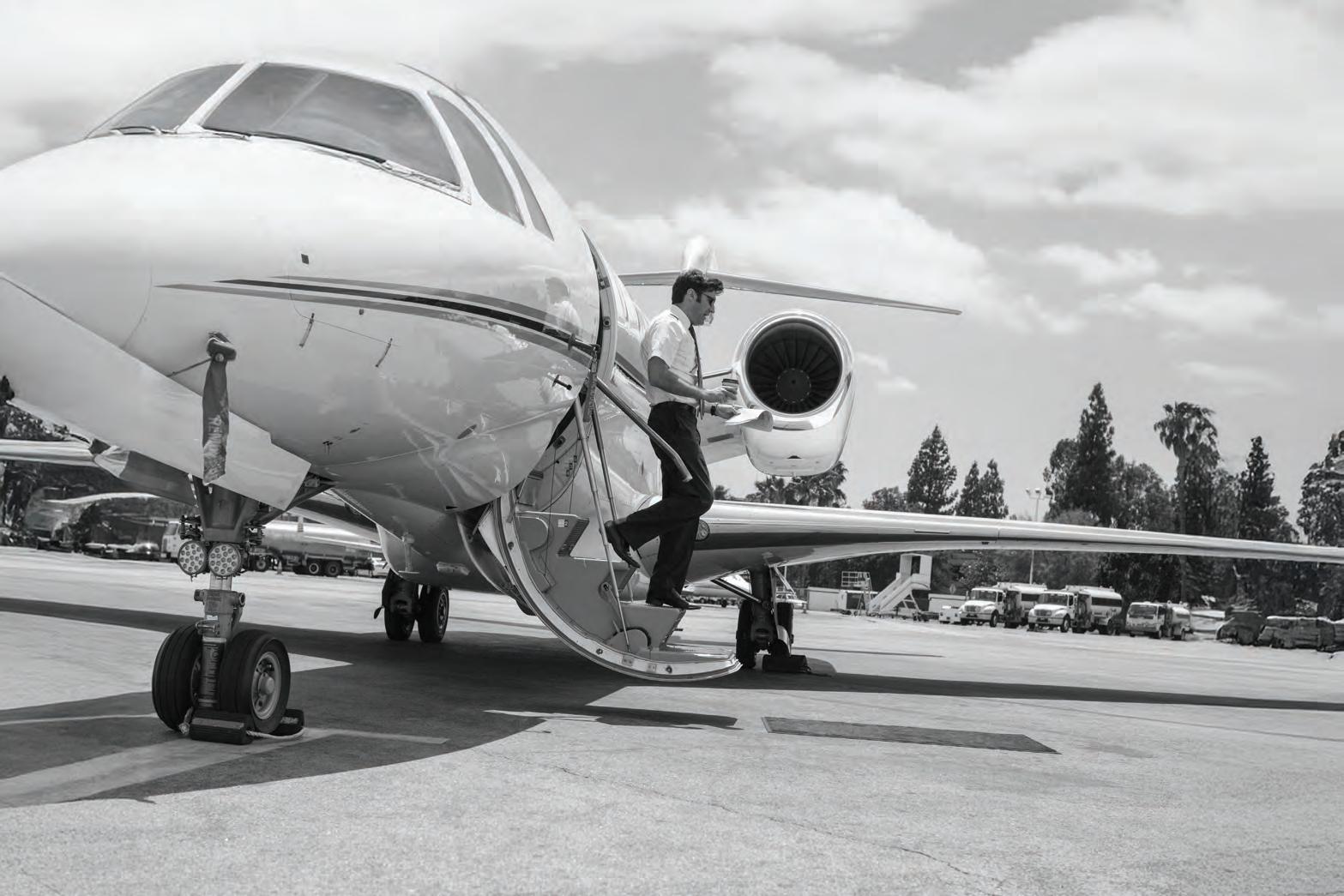
BY NEELAM MATHEWS
India’s business aviation sector continues to grow, yet its support ecosystem has remained underdeveloped and held back by systemic inertia rooted in siloed regulation under the Directorate General of Civil Aviation (DGCA), and the absence of a unified FBO policy.
India ranks third in the Asia-Pacific region for general aviation, with a fleet of more than 550 privately operated aircraft—over 75% of which are preowned. Used by high-net-worth individuals, celebrities, charters, and corporations, they serve luxury and business travel needs.
“India’s skies are booming. In the past four years, India’s private jet registrations surged by nearly 25%, and monthly private flights have tripled to over 2,400, the highest in Asia,” said Rohit Kapur, managing partner of The Jet Company for aircraft transactions and aviation consulting services. Kapur added that the market was growing between 3% and 5%, which is not huge but signals a trajectory.
terminal construction. A financial analyst told AIN that high commercial demand and steep costs—deposits and rentals exceeding $567,000—have made FBO viability “impossible” at these airports.
enabling Bird to leverage airport operator alignment and gain operational access and future expansion.
At VIDP, ranked as the ninth busiest airport in the world, Indamer MJets is part of a broader network that includes Indamer Technics, 50% owned by Adani Defence & Aerospace, linking to a 30-acre MRO hub in Nagpur. It operates a $20 million FBO featuring two 32,000-sq-ft hangars with luxury lounges, six private rooms for clients designed to prioritize confidentiality over open lounge formats, crew and customs areas, and integrated immigration facilities. It also offers MRO services for Bombardier, Embraer, and Leonardo aircraft. MJets at Don Mueang, Bangkok, was voted Asia’s best FBO and fourth best in the Eastern hemisphere by AIN readers in 2021.
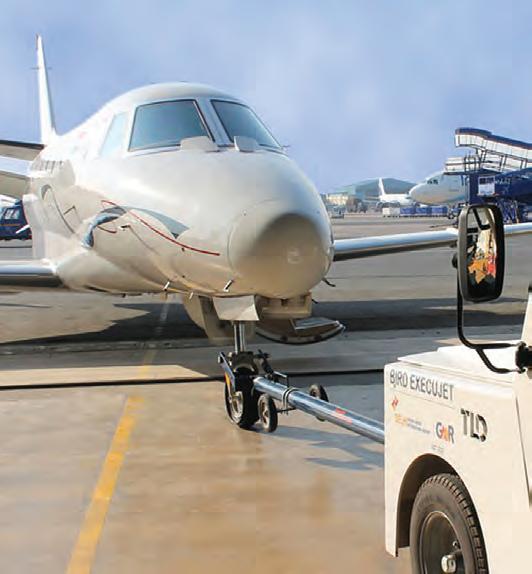
The DGCA’s June 2025 rollout of International Civil Aviation Organizationaligned audit reforms signals a move from fragmented oversight to integrated, riskbased governance. Standardized licensing and clearer service norms aim to boost regulatory coherence and attract investment. Sector-wide FBO alignment—standardizing operations, infrastructure, and service delivery—is expected over 12 and 24 months, depending on entity maturity and enforcement pace.
However, India’s FBO footprint is sparse, with fewer than 10 full-service facilities nationwide. Upcoming greenfield airports in Delhi and Mumbai have yet to begin GA
Indira Gandhi International Airport(VIDP) in Delhi hosts two FBOs— Indamer MJets and Bird Delhi General Aviation Services (BDGASPL). Bird’s 2005 joint venture with ExecuJet Aviation was rebranded following ExecuJet’s quiet exit post-2019, reportedly driven by legal challenges, shifting partnerships, and Luxaviation’s global strategy reset. “Foreign exits undermine investor confidence and disrupt delivery of global-standard services, exposing persistent regulatory and infrastructure gaps,” said Rajeev Gupta, CEO of Indamer Aviation.
In January, GMR Airports acquired a 49% stake in BDGASPL for $1.8 million,
BDGASPL operates two enclosed MRO hangars, each spanning 21,500 sq ft, with an additional 50,000-sq-ft apron for minor maintenance. The hangars accommodate six to eight midsize business jets, providing services to the Gulfstream IV, Hawker series, Cessna Citation, Beechcraft King Air, and Piaggio Avanti.
With just over 800 movements a month, Kapur said two FBOs were not required in Delhi. “Indian users of private jets are price-conscious and not happy to bear extra-large costs if they are fast-tracked. Monthly service pricing for a Delhi FBO typically ranges from $14,000 to $22,000 for midsize jets. Peak-hour surcharges, security fees, and infrastructure charges regulated by VIDP and Airports Economic Regulatory Authority of India further elevate costs.
RKBali, managing director of the Business Aircraft Operators Association (BAOA), however, felt there should be three FBOs at the airport because the Competition Commission mandates it.
Bali explained that the master plan for regional FBOs has not been cleared yet. The “Viksit Bharat,” a roadmap to making India a developed nation by 2047, would bring in immense changes for business aviation. “By that time, Delhi will have more than 100 flights a day.” Already, he added, regional airports such as Lucknow, Kanpur, and
Allahabad had plans for FBOs. An official told AIN that development with such projects had a lot to do with proactive state governments.
“We do not need fancy glittering GA terminals that charge heavily for parking and landing. The industry requires small independent terminals like Le Bourget, where customers do not have to bear the cost of a large airport infrastructure structured for commercial aviation. That is the need for business aviation,” said Kapur.
Navi Mumbai International Airport (VANM) has added 23 dedicated stands
for private jets and general aviation. Notices have been issued to aircraft owners at the current—also Adani-owned— Mumbai Chhatrapati Shivaji Maharaj International Airport, directing them to relocate to VANM’s new facilities, Adani Airport Holdings CEO Arun Bansal told AIN
Bali cautioned: “With both Mumbai airports owned by Adani Aviation, BAOA will need to keep an eye on the possibility of slight monopolistic tendencies. Or the trend could catch up with future FBOs.” z
The Aero Asia 2025 show, set to be staged in Zhuhai from November 27 to 30, should provide fascinating insights into the state of general aviation in China, but also a glimpse of the country’s fast-emerging low-altitude economy based on expanding applications for drones and eVTOL aircraft. Organizers are expecting that 300 exhibitors from 17 countries will interact with around 60,000 visitors at the Zhuhai International Airshow Center.
As of the start of September, the exhibitor list was dominated by Chinese companies, spanning a wide array of OEMs making light aircraft, drones, engines, and components. There will also be some groups from Cambodia, Malaysia, Japan, Korea, and Singapore.
Messe Frankfurt and Zhuhai Airshow Group, which organize the biennial show, said they were in the process of confirming more international exhibitors anticipated from countries including Australia, Austria, Belgium, Canada, France, Germany, Italy, Malta, the UAE, and the U.S. Despite the ongoing trade tensions between the U.S. and Chinese governments over the Trump Administration’s tariffs, the organizers appear optimistic that this will not diminish American involvement in the event.
Anticipated international OEMs among Aero Asia exhibitors include Cessna, Pilatus,
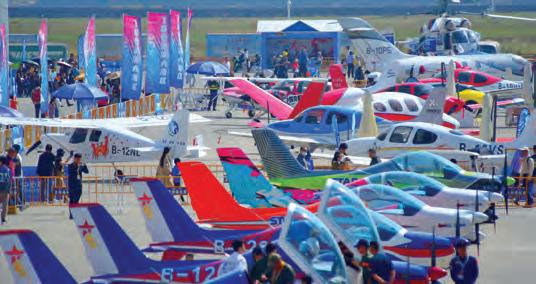
Pratt & Whitney Canada, Garmin, and Airbus Helicopters. Leading Chinese eVTOL aircraft developers such as Aerofugia, AutoFlight, EHang, and Volocopter are also set to have products on display in Zhuhai, which is part of the Guangdong-Hong Kong-Macau Greater Bay Area.
At almost 650,000 sq ft, the 2025 show is expected to occupy nearly twice the space of the inaugural Aero Asia event in 2023. Organizers have the support of multiple Chinese government and industry bodies, as well as major manufacturers including Aviation Industry Corporation of China, Aero Engine Corporation of China, and Commercial Aircraft Corporation of China.
The visitor profile is expected to cover a variety of sectors, including logistics, emergency
Companies from China and other Asian countries will exhibit at Aero Asia, but many other countries are expected to participate.
services, public security, agriculture, marine, energy, flight training, and aerial surveying. Extending across five halls,the exhibit space will feature companies located in zones allocated for the following categories: business and general aviation aircraft, rotorcraft and other VTOL models, drones, engines, green energy, infrastructure, and components, plus maintenance, repair, and overhaul, and other services.
Messe Frankfurt also organizes the annual Aero Friedrichshafen show held in southern Germany. The April 2025 event included, for the first time, a dedicated business aviation area, with major exhibitors including Bombardier, Dassault, Gulfstream, and Pilatus.
AIN Media Group is an official partner of Aero Asia 2025 and will provide extensive coverage of news from the show. C.A.
BY MATT THURBER
In-flight connectivity is a rapidly evolving field where online access has become a must-have, not a nice-to-have. Once, passengers were hoping for the ability to text, and now they want offices in the sky. Reliability and speed have become commonplace, rather than a target. AIN brought together experts to discuss how the industry is meeting the demands of these changes and what to expect in the future. Viasat sponsored this roundtable.

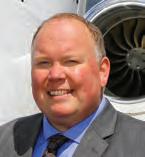


CLAUDIO D’AMICO VICE PRESIDENT OF STRATEGIC MARKET ENGAGEMENT, BUSINESS AVIATION FOR VIASAT
Claudio D’Amico has served with Viasat since January 2014, initially as program director. He began his career in 2001 with Embraer as a market analyst and also held management roles with Goodrich and later UTC Aerospace Systems MRO Brasil. A global communications provider, Viasat has served the business aviation sector for more than 30 years and has some 5,000 jets in its network. Viasat, which in 2023 acquired satellite specialist Inmarsat, o ers an array of services, from L-band and SwiftBroadband to Ku-band and Ka-band satcom.
JAY HEUBLEIN PRESIDENT OF FLEXJET TECHNICAL SERVICES
Jay Heublein has served with Flexjet and a liated and predecessor companies for more than two decades, also holding leadership roles with Flight Options and Nextant Aerospace. He has further served in a senior sales capacity at CitationShares. Fractional ownership provider Flexjet is one of the largest business aviation fleet operators globally. The Cleveland-based company is also an integrator of Starlink and has been converting its 400 aircraft to the service. Involved in in-flight connectivity for decades, Flexjet first introduced air-to-ground [ATG] technology in the 1990s and has worked with an array of connectivity technologies.
JASON WISSINK PRESIDENT OF SERVICES AND CONNECTIVITY FOR HONEYWELL
Jason Wissink has served with Honeywell for more than 17 years, beginning as a senior program analyst in 2007. Also a former software engineer with Intercomp, Wissink has been involved with the connectivity side since Honeywell introduced its JetWave solution more than a decade ago, working with Inmarsat. The aerospace giant now has more than 1,000 installations and is working on its next-generation product, JetWave X.
MICHAEL SCHRAGE — RESEARCH FELLOW, MIT SLOAN
Michael Schrage, a research fellow with the Sloan School’s Center for Digital Business, is also a visiting fellow at Imperial College’s [London] Innovation and Entrepreneurship program and has authored several books on the role of collaborative tools and technologies that enable innovation. He has further served in consulting and advisory capacities with Viasat, Microsoft, Procter & Gamble, British Telecom, BP, Siemens, Embraer, Google, iRise, and the O ce of Net Assessment.
CLAUDIO D’AMICO There’s definitely a change in our industry. We went from being able to send a text on an airplane, and that was good enough 20 years ago, to using that aircraft as an extension of our office or living room. That’s the expectation when you’re flying on these business jets, but at the same time, the technology of the aircraft has improved significantly. We have airplanes flying longer distances, and I think that also has a big impact on connectivity for our industry. [New] jets are equipped with connectivity as a musthave solution. It went from a nice-to-have to a must-have.
There’s consolidation happening. It happens in every industry that is maturing. You have innovators, then some consolidation, and we’re seeing some of that.
The demographics of our passengers are changing. At one point, speeds were very important. We participated in that process. But now, with this maturing in the industry, we’re seeing experiences being more important. And how do you characterize that? That’s how the whole customer base is evolving.
Obviously, we’re seeing LEO [low-earthorbit] entrants. From Viasat’s perspective, competition is good. It forces us to continue to innovate and bring better solutions to our customer base.
We think that a multi-orbit solution backed by high-capacity and flexible satellites is where you can continue to innovate and drive improvements in terms of experience. The folks who focus on customer problems and at the same time continue to evolve and deliver capacity in a very efficient way [will prosper].
We are continuing to expand our network. We have some very high-capacity satellites being launched and integrated into our network. Viasat entered service with ViaSat-3, a
high-capacity satellite, in the summer. We have more of those satellites coming. Those satellites bring an immense amount of capacity to keep us ahead of the game.
We’re bringing five times the capacity over North America for our GX customers. We’re not just focused on a GEO solution or geostationary orbit for our satellites. We have our GX-10 satellites coming online next year, and those are high-ellipticalorbit satellites that provide coverage over the North Pole. It’s the first step in terms of multi-orbit for us. The backbone for us is being able to have these high-capacity GEO satellites and focus that bandwidth over areas with a lot of demand.
JASON WISSINK We’re seeing a combination of multiple things that are expanding the choices that operators have. The established providers like Viasat are adding significant amounts of capacity. Our goal is to make sure that the available equipment—not just available on the shelf but certified on the right airframes—has access to the latest and greatest capacity. We have to stay very close with companies like Viasat to understand those roadmaps, timing, modems, waveforms, all that stuff, so that when the capacity becomes available, people can get access to it right away.
On top of that, there are a lot of new entrants and disruptors. Starlink is one of them, and they’re driving a change into the market, in terms of what experience should be expected. As a manufacturer, we have a combination of people that we’re partnered with, and then some folks are more vertically integrated that we still need to find a way to work with, because you end up with aircraft that have multiple systems installed. What passengers want is a system that works great and provides a great experience.
We’re seeing more and more [installation of systems that connect to di ff erent networks]. It’s already happening in the airlines. Multi-orbit and business aviation is a bit more of a challenge from an equipment perspective, because you’re limited in terms of the size of the fuselage. You can’t put massive antennas [on them]. But we do have access to the tail. You can put smaller ESAs [electronically steered antennas] on the fuselage. If you find a way to integrate those types of systems well and provide a very good experience, you can get beyond just redundancy. Redundancy is great, but these systems are pretty reliable now, and you can get to a point where you’re running them both at the same time and providing an even better experience.

MICHAEL SCHRAGE Let’s not confuse greater capacity with capability and how that capability is experienced. This is where the Honeywells of the world are going to play an enormous role. Jason talked about systems integration and the user—whether a pilot or in the back of the plane—doesn’t want to deal with that kind of complexity. They just want the thing to work. What I think is going to become very important is classic UX [user experience] design—what are the personae of the users, and what are the edge cases that will test the capability of the system?
One of the real issues for Starlink, for Viasat, for Honeywell, for Collins, is if you’ve got the children of [the owners] on a jet, and they are influencers on Twitch, how well can they do stuff on Twitch as opposed to just stream a Netflix movie? What kind of latencies are acceptable?
That raises one last issue. I think metadata matters. The intent of the user matters. I think the Honeywells and Viasats are going to be doing packets that are metadata-labeled as “this is a game, this is a Zoom.” This is a high-priority issue.
I think there’s going to be more intelligence in the system, and capacity is not just going to be about greater speeds; it’s going to be about facilitating intelligent continuity for the user.
JAY HEUBLEI n We all run our businesses using [key performance indicator] KPI data. [Last] Sunday, we had 380 live legs. The only negative KPIs that I saw, somebody had bad catering on one flight, and on three flights that had legacy connectivity equipment, they complained that the connectivity didn’t work. Think about how complicated it is to run [those] flights, all the logistics, all the operations that go into that. We can run a perfect flight. The airplane could be perfect. The flight can be on time. And now we’re down to whether or not their in-flight connectivity experience mirrored what they expect.
Four to five years ago, from our perspective, we were struggling. We were all

Passengers’ expectations have evolved as in-flight connectivity has become more reliable.
happy when we could do basic text and emails back in the ’90s, and then, almost immediately, “I can’t stream. I can’t host video conferencing.”
It’s amazing how fast the expectations have evolved. Five years ago, we were challenged with the lack of consistency in in-flight connectivity. There’s been great progress in technology. And Ku was a big step up from ATG, and then Ka got even better. But if you have a less-than-perfect connectivity experience, our customers think of the flight as a failure.
We thought about getting into the connectivity space. We put a fund together. We were thinking about buying a connectivity solution. We looked at all the different options. And during that diligence, we came across Starlink.
We focused on the things that create challenges for us. When you’re flying 400 aircraft, Ka and Ku were a huge step forward. It’s very complicated equipment, though. The thing that we liked about Starlink was this idea that if we get away from moving [antenna] parts, anybody who manages airplanes would tell you there’s an advantage in that. So we decided to go all-in on Starlink.
When we try and solve for something with Flexjet, we look at monetizing it in
different solutions. So, we’re an integrator for Starlink. I think [we’ve developed] about 20 STCs [supplemental type certificates], and in a year, we delivered almost 800 kits.
It’s going to take two years to integrate Starlink on all 400 [aircraft]. We’re about a year into it. Now the complaint I get is, “I’m still flying in an ATGequipped airplane,” and the experience isn’t the same.
In the last couple of years, we’ve crossed the reliability threshold. In the 110, 120 airplanes that I have flying with Starlink, I’m aware of two mechanical issues, which is incredibly low compared to what we’ve dealt with 10, 15 years ago.
JAY HEUBLEIN When we talk about KPIs, we woke up one day and the average number of devices that are connected went from maybe six to eight to somewhere north of 38 to 40 on an average business jet flight, even though there are only three passengers in the back of the airplane. It’s gotten incredibly more challenging to meet expectations, and that’s what the new equipment is doing, and that’s what we’re excited about.






















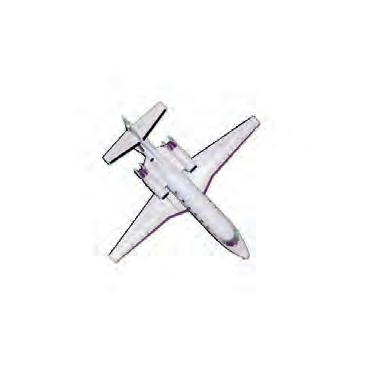
Had enough of empty speed promises?
Viasat’s JetXP unleashes the full power of our global network for business aviation customers to deliver an even more reliable, consistent and snappy Wi-Fi experience. Anytime. Anywhere.

MICHAEL SCHRAGE What you’re describing is literally an order of magnitude more devices. How are you using metadata? Do you have to become a systems integrator in the air to manage these sorts of things? You and I both know that a certain portion of your flyers are having ChatGPT and Claude [AI chat] conversations, and at the same time, their kids are streaming things. How are you addressing the orchestration, coordination, and intelligence challenge of that? Because it’s 10X more now than it was five years ago.
JAY HEUBLEIN Think about 14 to 16 passengers being the maximum that we’re dealing with. We are not bandwidthconstrained. Whether it’s Ka, whether it’s using a Starlink phased-array antenna, they’re all keeping up with the demands of those passenger loads in the business jet segment. What we really did is solve for content management and in-flight experience, because we’re no longer constrained by bandwidth issues. So that has opened up all kinds of opportunities for our owners.
CLAUDIO D’AMICO There’s an increasing amount of capacity, and there’s a step change in terms of performance being delivered to connectivity customers
today. We’re addressing that with high-capacity satellites that are flexible. Our strategy continues to be to deliver these high-capacity satellites and augment our network with other types of solutions.
The idea is that we can stay ahead of the demand, especially as the network and the number of customers increase. We think we can do that with the roadmap that we have in place, even though as you add a lot of customers, it’s harder to sustain a certain level of experience in areas where there’s a lot of demand. That’s why we’re focusing on our GEO-backed roadmap, augmenting it with a multi-orbit strategy.
CLAUDIO D’AMICO Customers have mentioned they liked the consistency and the reliability as our network grew. There are certain flight routes that we struggled a little bit with for some of the large-cabin market. In the summer, we deployed 5X the capacity over that, and the performance has improved. They have recognized the improvements, and I think that was the first step in making that step change for us. As we further integrate Viasat and Inmarsat, we can bring a lot more to our customers. And as we evolve equipment,
in collaboration with our partners, we can also bring even more capacity.
I think customers also like the support. We’ve worked with our OEM partners, with our service providers, to deliver a whiteglove type of support. They appreciate having that type of attention.
JAY HEUBLEIN My issue is I can’t move fast enough to [upgrade]. To be clear, we’re not talking about Honeywell systems. We’re talking about older ATG-type technology, where the experience is nowhere near the same as what is available now. It’s a race for us to get them on. We started with all of our large-cabin aircraft. We got through those fairly quickly. Next week, we’ll start our last STC, which is for our light jets.
We think we can’t move fast enough for them. That’s the complaint we get. It’s coming.
Our experience [with Starlink] has been spectacular. We’ve got thousands of hours of flight time. I’m aware of three total mechanical issues ever with the equipment. Ka was a game-changer in terms of in-flight connectivity, but that’s relatively big equipment. [Starlink] let that experience go to all different sizes of aircraft.
JASON WISSINK Talking about Ka, the existing JetWave customers have certainly begun to experience the increased capacity over North America. We see it in the data. We’re seeing peak speeds increase quite substantially and usage going up.
The reception on our newer system that we’re just finishing up—JetWave X, we bring that into the service at the end of this year— people appreciate the flexibility we built into the system. They understand what they can expect the experience to be [as they] access Viasat’s latest and greatest satellites.
The feedback we get is very similar to what Jay hears: “I like what I’m seeing in this lab or test flight. I want it on my airplane right now.” That’s where we work, as closely as we can with the installers and OEMs, because it takes everyone to get
the certification done, get the testing done, and the install done. The faster we can do that, the faster we can truly bring these experiences to people.
[JetWave X] over-the-air testing has begun, and we’ve got it on one of our test aircraft. We’ll be flying that here very shortly. Things are starting to move here pretty quickly. And now we’re getting into much deeper discussions with the service centers on STCs and production fit.
JAY HEUBLEIN Our large-cabin data subscription rates are probably half what they were five years ago. That’s because there are multiple solutions and not just because we have a LEO solution. But there has been a reduction in data costs.
CLAUDIO D’AMICO I think there has been. It’s about which service plan you’re selecting and how you want to operate the aircraft. One of the things that we’re focused on is how do we measure that experience, so we can quantify that experience going forward. There’s a lot of talk about speeds and how you define that experience side of things. We see speed tests on our network of over 150 megabits per second. We don’t talk about that because we want to make sure that we’re consistently delivering that experience.
JASON WISSINK
An interesting challenge that owners and operators have today is the challenge of choice. Choice is a good thing. When you bring new entrants into a market competition, the customer typically benefits. I think you’re seeing that in in-flight connectivity, but because in the world of equipping aircraft, switching costs are really high. It’s not like choosing between AT&T and Verizon. It’s like, I have to put the airplane down. I have to do wiring, all that stuff. So making the wrong choice can be a struggle.
People are asking a lot of questions today just to try to understand, “I get what I could put on my airplane right now. What do you think it looks like in three years… in five years?” Those are the questions that we’re trying to be cognizant of as we design next-generation products.
Flexibility, integration, and simplicity are the things that we think are going to be important to give people a great experience. It doesn’t have to be complicated. People just want to get on the airplane, and they want to work, and they want to do what they want to do. Those are the things that we’re trying to take into account as we work on our next generations of equipment.
MICHAEL SCHRAGE This is an architecture question. Here I am, calling in on an Apple [device], and now and then my OS gets upgraded. Here you are, Jason, you’re looking two years down the road. To what extent are you building equipment with firmware capabilities, upgradable capabilities, so that you use software enhancement as a substitute for hardware improvement?
JASON WISSINK If you have an antenna that can serve the whole frequency range of Ka or Ku, you have an antenna that can theoretically talk to any satellite. Then it comes down to, do you have the right modems and waveforms, and things that you need to communicate with a certain satellite. That was very hardware-based and proprietary in the past. We are seeing the industry move towards more softwaredefined waveforms.
I do think there is a future where if there’s a new network, or a new satellite, but you need to change the waveform or something, it can be much more software-defined, versus rip all this stuff off the airplane and put new stuff in. The industry is going that way, but there remains work to be done.
JAY HEUBLEIN One of the biggest challenges we went through with our partner early on was that they were constantly evolving the software, and we had to build a rig so that we could test all this in a lab and not have to deal with rollouts into the aircraft. It was a little challenging, but it’s very heavily driven by software. The technology evolves weekly, and [so does] my software.

CLAUDIO D’AMICO
One of the things that I think is important is how you build flexibility into the design of that satellite. I think there are software-defined protocols on satellites as well. You have to be able to incorporate that into your design so you can continue to serve the market, evolve the offering over the years, as technology and equipment evolve.
Some of the newer satellites that Viasat is launching now, we’ve incorporated a lot of those features, so that when you upgrade or you have access to that satellite, that’s sustainable over the years. It’s definitely an important factor for Viasat.
The other thing that’s super important that we think about is security. What are the security requirements that you have and that your customers have? As you think about the design of that satellite, how secure is it? Who is using it? All these are things that we incorporate as part of the asset and satellite development.
We have specific requirements on how certain terminals need to be able to operate on Viasat’s network. We collaborate with Honeywell, and there’s a terminal that has been very successful in this market, JetWave, which is on the majority of the large-cabin jets. Honeywell has been talking a lot about the development of JetWave X, which brings
a lot of that flexibility to the market. We do that with every partner we have, so we’re in lockstep in terms of the technology, in how we can evolve the overall service offering.
JASON WISSINK Claudio said it pretty well. We exchange requirements and all the things that you would typically do when you’re building equipment for a network or an aircraft, but there is an extensive amount of engineering coordination between the companies. We’re in each other’s labs. We’re on test airplanes together. We submit documentation to regulatory officials together. It’s two separate companies, but you almost need to function as one team. At the end of the day, the customer doesn’t care about the antenna. I wish they did, but it’s just a thing that provides an experience. We want to make sure that our piece of the value chain does exactly what it needs to do.
MICHAEL SCHRAGE My experience working with large organizations, not airplanes, is that at a certain point when you’ve got a lot of data streams and workflows going on, there needs to be some intelligence layer and coordination, and metadata matters as much as capacity.
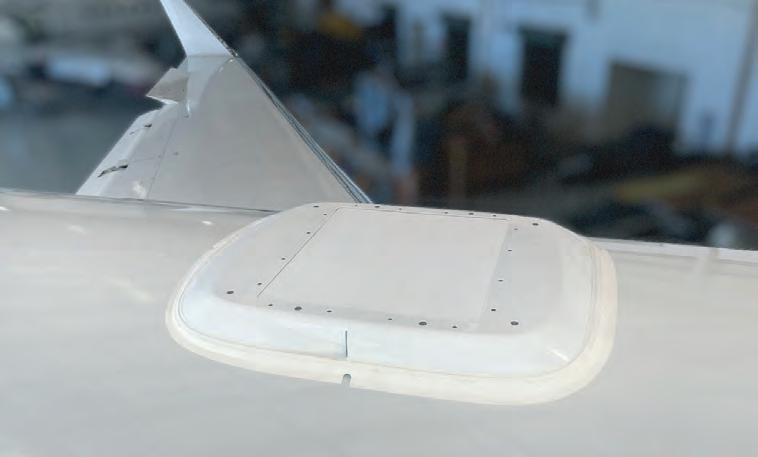
I don’t believe the future of greater bandwidth and greater capacity is going to be less intelligence in flight. I think that, Jason, there will be GPUs on planes, coordinating these kinds of things, because it’s exactly what you said, Jay, people want their terrestrial experience in space. Every place where people are compute-intensive, there’s intelligence coordination going on with that.
JASON WISSINK I completely agree with what you’re saying. When we look at the history of how things typically evolved with in-flight connectivity, the newer networks come out, they always have tons of capacity. Much more than the previous generation. And performance is a step change, just like we’ve seen three or four times now.
Eventually, demand will start to outpace the network, because it’s just the nature of how things have worked in connectivity, and then you do have to get smarter about how you’re using the bandwidth. So in my view, you absolutely need both. Capacity is the baseline. But in the world of satellites, “more more more” isn’t always feasible. You do need to smartly manage the capacity, because there is a lot of background activity that happens with connected devices that people don’t know is happening, As you start to approach that point where things are starting to get a bit constrained, those smarts become very important.
CLAUDIO D’AMICO We think a lot about that. I agree with what Jason has said that a lot of these things should be transparent to the end user. The end user is being bombarded with a lot of information when the only thing they’re looking for is, “Is this system enabling me to do whatever I want to do?” I think that’s how we have to evolve. How do we change that conversation to something more meaningful in terms of experience?
In the past, [we were] trying to train people to associate value in performance with a specific speed test. That is not a good metric. We think about terminal availability.
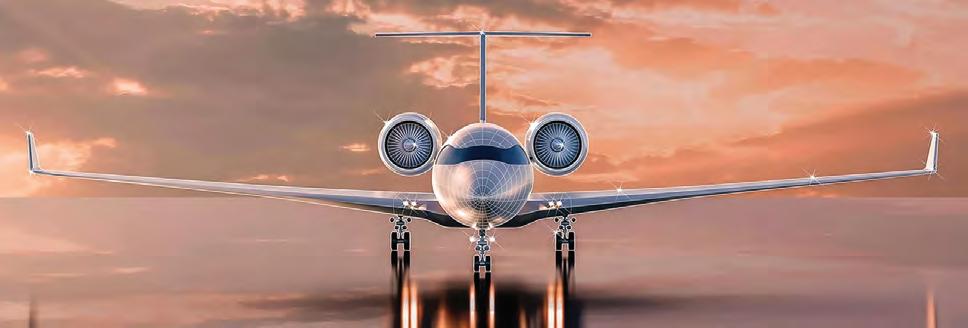
How can you monitor your equipment?
How can you get maintenance logs? We look at signal strength. That’s also part of reliability. We look at performance. What’s the resilience of that transmission, measuring the network capacity to minimize packet loss? For us to do what we’re doing here on a video call, if you’re losing packets, it’s not going to be a good experience.
We’re looking at all of this from a network standpoint, and we’re trying to come up with…a metric that makes that simpler to users. I think the cell phone industry has done that when you look at the little bars on your phone. If you know you have 5G and you have five bars, you know you can do pretty much whatever you want.
How do we develop that metric, and then how do we ensure that our customers associate the experience with that metric? In the background, we can use these KPIs and work with integrators and equipment partners on the network to make adjustments necessary to deliver the quality of experience that our customers are expecting.
JAY HEUBLEIN We’re a technology integrator. We’re not launching the satellite or putting the constellations into space. We’re not building the core technology. We’re integrating it, and then we’re consuming it. Our decision-making was whether we could reproduce a terrestrial-like experience. That was the starting point. This is a very capitalintensive world to play in. There aren’t that many groups that can do that. We spent a lot of time evaluating financial viability and what it was going to cost to carry out the
mission that we wanted to benefit from. Could we have a reliable system? Could we put standardized equipment on every single one of our aircraft?
Just to make you laugh for a second. We had a customer call in…and he went out of his way to map the data transmission speeds. He said, “I only average 230 megabits per second. I want to see 300.” And we had to have a conversation: “Were you limited in anything you or your family wanted to do?” And he said, “Absolutely not.” We created monsters looking at the data.
JASON WISSINK There will be more networks. I think the current providers will continue to expand capacity. Business aviation isn’t a huge industry; it’s relatively small compared to the airlines or even defense, but it’s a very demanding industry. The industry has already consolidated pretty significantly. There might be a little bit to go, but we’re getting down to the two or three that are going to serve the market. For the remaining folks who are in it for the long run, I think there is enough business. This is a market that we remain extremely passionate about. Satellite connectivity continues to be an area that we’ll continue to invest heavily in, and our goal is to make sure we’re keeping up with the rate of change.
JAY HEUBLEIN We’re talking a lot about consumer experience with connectivity right now, but safety-sensitive connectivity [is
CLAUDIO D’AMICO What customers have liked about what we’ve offered was initially the consistency, the reliability of the equipment, and the performance. We’re going to continue to expand that. One thing that is going to be a key differentiator in this market, to be able to serve the requirements of our customers, is the support side. Honeywell continues investing in satellite connectivity and recently began testing its new JetWave X platform, which is expected to enter service at the end of this year.
important], and [also] those types of things that are going to drive the future of avionics. Why do I have to have two platforms to do that? When you think about things that are going to evolve, I think that’s going to see more and more evolution [to a single connectivity system for the whole airplane]. I think eventually we’d like to get away from [separate systems]. Reliable connectivity is reliable connectivity, but there’s a lot of room to continue to evolve different aspects of it. These are very expensive assets. So anytime you make an equipment upgrade, you’ve got the capital cost of the new equipment, but you’ve also got the cost of the downtime of the aircraft. So, a large-cabin airplane that’s $45 to $65 million, you don’t want that sitting on the ground for a couple of weeks. Even a simple system like we’re installing is still, on a large-cabin jet, about 500 labor hours. You don’t want to be making these decisions every year. That’s the big decision-making consumers have to make: “Am I future-proofing the equipment as best as possible? Am I limiting the number of times that I have to go through this experience? Am I going to get the in-flight experience that I’m expecting?”
An FAA move to restrict public access to aircraft owner information based on the 2024 FAA Reauthorization Act has inspired both laudatory and concerned reactions across the aviation ecosystem.
Groups such as NBAA and AOPA hail the privacy changes and possible expansion of them; increased privacy and security protections have long been a priority for the business and general aviation community, especially in the decades since individuals could track aircraft movements online.
However, airport officials, aircraft transaction attorneys, and some industry associations warn of potential operational, financial, and legal consequences of blanket blocking of that information.
Implemented earlier this year, the changes were mandated by Section 803 of the FAA Reauthorization Act of 2024 (Public Law 118-63), enabling owners to submit privacy requests through the Civil Aviation Registry Electronic Services (CARES) system. Names, addresses, phone numbers, and email addresses of registered owners can be withheld from
BY AMY WILDER
public FAA websites at the owners’ request.
In addition, the FAA is considering whether to automatically withhold personally identifiable information from the public registry by default while providing owners with a means to access their data when necessary. A request for comment drew more than 300 submissions.
“Publicly available, personally identifiable aircraft information has helped enable flight-stalking by anyone, anywhere in the world, with any motive,” NBAA commented in early June, backing the increased privacy. In congressional testimony, NBAA president and CEO Ed Bolen said the industry supports protections that mitigate threats without creating unintended consequences.
The AOPA also supported the move. “This program is long overdue and a significant win for pilot privacy,” said AOPA president and CEO Darren Pleasance. He added that AOPA would continue working with Congress and the FAA to ensure pilots’ private information remains fully protected.
Meanwhile, title company representatives fear that complete privacy limitations could lead to problems with aircraft titling and sales. “Making sure that people cannot track flights is not a bad goal. There are security reasons, there are safety, maybe even confidentiality reasons for businesses,” wrote AIC Title Service general counsel Bruce Marshall in one of the comments. “But the problem is…the FAA was co-mingling operational information, ADS-B information, and ownership information. The registry originated so that you could follow the legal documents and have some way of determining ownership and interests in aircraft.”
The American Association of Airport Executives (AAAE) warned the FAA that removing data without preserving access for verified users would hinder national programs, such as the FAA’s own aircraft inventory. AAAE urged the agency to develop a secure-access portal for credentialed airport users, noting that the statutory authority for privacy applies to “individuals,” not corporate entities. Under an act mandated by Congress, the FAA was forced to allow people to remove aircraft ownership from publically accessible FAA websites, and this is raising concerns among aircraft title companies and others who fear that this will hinder transactions.

State revenue agencies echoed the concern. The Missouri Department of Revenue said removing public registry data would harm tax compliance and recommended formal information-sharing agreements between the FAA and state governments.
Aircraft financiers and attorneys worry the changes would upend due diligence and open the door to fraud. “It would be like buying a house and not checking the title,” said Clay Healey of AIC Title. “We can’t do our jobs for people.”
Scott McCreary of McAfee & Taft, writing on LinkedIn, called the registry changes “inherently more complex” than past FAA digital reforms. He noted that registry access is critical for parties establishing or verifying ownership, liens, and operational structures. McCreary urged the FAA to maintain full document access in its Public Documents Room for vetted users.
The FAA aircraft registry is an ownerbased system, meaning it often lists the legal titleholder, not necessarily the aircraft operator. In many cases, the operator is a lessee, trust beneficiary, or related company. As McCreary noted, restrictions on LLC disclosures could also unintentionally expose beneficial owners even when privacy structures are in place.
In light of the widespread criticism, stakeholders are urging the FAA to adopt a tiered-access approach that protects individual owners while maintaining verified access for those with operational, legal, or regulatory responsibilities.
Meanwhile, industry advocates continue to call for transparency, dialogue, and regulatory nuance. “There is no way we can exist if they take all that information away,” Healey said. These protections are the latest effort to shield owners as technology has increasingly made that more difficult. “As soon as the technology was available to track, people wanted to do it,” said Doug Carr, NBAA senior v-p of safety, security, sustainability, and international operations. “This began back in the mid- to late 1990s, when the internet was still nascent and ascendant.”

But at the same time, people began to question whether their movements needed to be on the internet in real-time. Security issues, along with personal and business privacy concerns, were immediately raised. By the early 2000s, business aviation began to ask for a program to shield this access to information, in real time.
NBAA gathered impact stories from business leaders who found their competition had been a step ahead by tracking their aircraft patterns to individuals being followed by their “biggest fans.”
The cases have been numerous, including sports figures’ trades discovered by reporters tracking them, and activists targeting celebrities through aircraft movements. Even war veterans would return home to face protestors who had tracked their aircraft.
“All of these people, for various security or competitive reasons, had real concerns. It illuminated the types of concerns people might have when they get tracked and their flights get broadcast in real time,” Carr said. Initially, attempts to stem such activity resulted in the Block Aircraft Registration Request (BARR), which would enable operators to ask the FAA to shield aircraft registration information from flight trackers working with the agency. Those flight trackers abided by such activity.
But the number of other organizations and individuals who tracked aircraft and released that information online—outside of the BARR program—grew, requiring tweaks to the program. And then, the advent of mandatory ADS-B provided another means of unmasking aircraft movements, leading to the transition of the BARR to the Limited Aircraft Data Display and Privacy ICAO Address programs.
The aircraft registry changes are the latest layer of protection. Carr concedes that it is not a complete answer. “There is no silver bullet to this. What it will do is make it harder to identify a blip in the air because today, that information is easily referenced with the aircraft registry database at the FAA.”
Carr acknowledged concerns that there are several legitimate reasons for people who need to access the registration information. But as the FAA explores that access, Carr continued, to start with, “there are basically two statuses—You’re in the program or you’re not. While it sounds good, that may not be the best approach.”
NBAA agrees with the creation of a pathway for authorized users to access the information. He noted that it is in place with state driver registries. “It’s that approach that we think would facilitate a reasonable balance .” z
—Kerry Lynch contributed to this article
During AIN’s annual product support survey for aircraft, avionics, and engines, customers highlighted individuals who go above and beyond their call of duty. Below are many of those named and the praise they received.
MICHAEL ABRIL (BOMBARDIER)
“Very Good Communication.”
RANDY ADAMS (TEXTRON AVIATION)
“Sacrificing time to ensure a child’s return following medical treatment.”
GRAHAM ALLAN (LEONARDO HELICOPTERS)
“Well connected and works excessively hard.”
SUNE ANDERSEN (BOMBARDIER)
“He is always there when we need support, regardless of time. Always solves the problem.”
ADRIANO ANDRADE (GULFSTREAM AEROSPACE)
“Adriano is always very objective and supportive of our requests.”
ETHAN AU (BOMBARDIER)
“Strong and timely customer support. Ethan is a star!”
MARK AUXTER (GULFSTREAM AEROSPACE)
“He is a phone call away and stays engaged until a full resolution has been rendered.”
JASON AYLOTT (GULFSTREAM AEROSPACE)
“Always available, super knowledgeable.”
DIANA BARSANTI (DASSAULT AVIATION)
“Will carry the responsibility of the entire company to try and support the operator.”
NOEMI BAULNE (BOMBARDIER)
“Above and beyond.”
ANDERSON BELO (EMBRAER)
“Awesome tech rep. He delivered even more than expected. You rock!”
FRED BERTRAND (SATCOM DIRECT)
“Never misses a text. Always has an answer. 24/7 willingness to support.”
RICK BEST (TEXTRON AVIATION)
“Best technical rep. Gets problems resolved.”
HANNES BESTER (BOMBARDIER)
“Always available when needed. Professional in approach. Always willing to assist.”
KEN BLAD (BOMBARDIER)
“Knowledgeable, assists on all issues.”
STEVE BLOCK (BOMBARDIER)
“Great service.”
JULIEN BOUCHARD (BOMBARDIER)
“What customer support is all about.”
MICHAEL BOWEN (BOMBARDIER)
“Attentive, resourceful, and knowledgeable.”
DENIS CANTIN (BOMBARDIER)
“Utmost client commitment.”
JULIO CARBAJAL (TEXTRON AVIATION)
“Above and beyond services.”
FREDDY CARMEN (BOMBARDIER)
“Excellent service. Great professionalism.”
JOHN CARY (LEONARDO HELICOPTERS)
“He has done an outstanding job.”
PAULO CASTRO (DAHER)
“Excellent support across all aspects of support.”
AGNIESZKA CHRANIUK (BOMBARDIER)
“Excellent way she cares about the customers.”
HENNING CHRISTEN (BOMBARDIER)
“Always reachable. awesome to work with him.”

GIOVANA BILDA COELHO (MAGA AVIATION)
“Always there for the challenges, helpful, a warrior, and dedicated.”
MATTHEW COLBORNE (BOMBARDIER)
“Happy to help, makes experience personal.”
LUIZ FELIPE COLLODORO (BOMBARDIER)
“Quick response. Extremely committed.”
ROMAIN COMBEAU (DASSAULT AVIATION)
“Outstanding tech rep. Always available.”
RONNIE COOK (BOMBARDIER)
“Best in class. Reliable and thorough.”
FRANK CORONA (BOMBARDIER)
“Extremely experienced. Very attentive towards our account and the aircraft type.”
BRIAN COTTON (BOMBARDIER)
“Brian is very knowledgeable, and he goes the extra mile. Best in the business.”
ANTHONY COX (BOMBARDIER)
“Runs a world-class customer support team.”
SCOTT CRAWFORD (BOMBARDIER)
“A phone call away. Top-notch customer service.”
ROBERT CRESENZI (GULFSTREAM AEROSPACE)
“Excellent technical support!!! My go-to guy.”
DAN CROTTY (BOMBARDIER)
“Always willing to help support us. Continues to demonstrate excellent customer service.”
CARLTON CUSHING (DASSAULT AVIATION)
“Carlton is ALWAYS there to listen and support.”
RANDY DAVIS (TEXTRON AVIATION)
“Most helpful anytime you call.”
MYRIAM DIAZ (TEXTRON AVIATION)
“Attention to details and responsive.”
ALBERTO D’JESUS (GULFSTREAM AEROSPACE)
“Always on top of the game.”
ALICIA DONALDSON (TEXTRON AVIATION)
“Ensures customer support and communication.”
JEFF DOWDEN (TEXTRON AVIATION)
“Above and beyond customer advocate.”

ALEXANDER EBERT (GE AEROSPACE)
“Always supports me, very dedicated.”
MAXIME EDY (BOMBARDIER)
“Provides excellent support. Trust-based relationship. Very professional.”
ED FIORENTINO (DASSAULT AVIATION)
“Always available to assist with any issues that arise.”
ARNO FOREHAND (GULFSTREAM AEROSPACE)
“Makes each customer feel important.”
MIGUEL GALLARDO (GOGO)
“Extremely passionate about his service and representing his brand.”
NOE GARZA (PRATT & WHITNEY CANADA)
“Always answers [calls] and provides solutions.”
FREDERIC GELPER (BOMBARDIER)
“He has helped us tremendously. Will always follow up with any issue.”
NICHOLAS GERMANI (BOMBARDIER)
“Fantastic support. Really appreciated in region. Very knowledgeable and helpful.”

ILYA GOFMAN (TEXTRON AVIATION)
“Above and beyond for his personal inputs and customer care as EU field rep for Citations.”
MAX GOH (COLLINS AEROSPACE)
“Great technical knowledge and quick response to customer issues and onsite support.”
RAYMOND GRAHAM (CIRRUS AVIATION)
“Above and beyond.”
MIKE GRUMKOSKI (SATCOM DIRECT/GOGO)
“Always drops everything to answer your calls, especially when dealing with an AOG.”
QAIS HAMDAN (ROLLS-ROYCE)
“Always available to assist. Years of experience. Made our experience truly remarkable.”
OSKAR HAUG (BOMBARDIER)
“Always helpful and on-time reply.”
JONATHAN HEADLEY (BOMBARDIER)
“Has spent a lot of time checking on us, establishing vendor relationships.”
CHAD HEIMAN (BELL HELICOPTER)
“Chad is always available, very helpful, and informative. He is a credit to Bell Helicopter.”
ATILLA HEPUERKER (GE AEROSPACE)
“He is professional and attentive,”
RAPHAEL HERMES (BOMBARDIER)
“24/7 responsiveness. He did an incredible job.”
JUAN HERNANDEZ
(GULFSTREAM AEROSPACE)
“Always goes the extra mile for me every time.”
FRED HOUSTON (GULFSTREAM AEROSPACE)
“Committed to delivering exceptional service.”

SCOTT HOWELL (TEXTRON AVIATION)
“Is incredibly available to help with any issues.”
SHAWN HYGH (GULFSTREAM AEROSPACE)
“Goes the extra mile for me each and every time.”
LOR IZZARD (GULFSTREAM AEROSPACE)
“Lor always puts the customer first.”

STEVE JAINARINE (BOMBARDIER)
“Great customer service.”
IGNACIO “NACHO” JARA (GULFSTREAM AEROSPACE)
“The contact everyone needs to have.”
BRET JONES (BOMBARDIER)
“By far has been the most engaged FSR.”
GARETH JONES (BOMBARDIER)
“Exceptional communication, problem solving.”
ADRIAN JONES (BOMBARDIER)
“Honest, sincere, and looks out for customer.”
SCOTT JONES (GULFSTREAM AEROSPACE)
“Goes above and beyond.”
EMA KALAN (BOMBARDIER)
We have confidence we are in good hands.”
SUHYEON KANG (LEONARDO HELICOPTERS)
“Very helpful in the operation of the aircraft.”
ASHOK KAPADIA (EMBRAER)
“Best tech rep we’ve ever had. This man is gold!”
PETER KARLOVCEC (BOMBARDIER)
“Amazing customer support.”
VIGNESH KASIVISWANATHAN (EMBRAER)
“Technically sound and wide knowledge.”
WILLIAM KING (GULFSTREAM AEROSPACE)
“Great support rep.”
ILLIAS KIRITSIS (BOMBARDIER)
“Always willing to provide support.”
MARCEL KONTNY (TEXTRON AVIATION)
“Committed and technically very competent.”
ANIL KUMAR (ROLLS-ROYCE)
“Very professional. Exceptional responsiveness.”
JEFF LEISEY (DASSAULT AVIATION)
“Helps no matter what. Wealth of knowledge.”
OU “LEO” LI (BOMBARDIER)
“Leo is always responsive and very attentive to his customers.”
WILLIAM LI (BOMBARDIER)
“He goes beyond. Quick response and superb technology.”

SARAH LINTERN (BOMBARDIER)
“Always going above and beyond.”
LEN LIOTTA (GOGO)
“Attentive to customers’ needs.”
SAMUAL LOCKWOOD (GULFSTREAM AVIATION)
“Excellent knowledge. Always responsive.”
ALEJANDRO GARCIA LOPEZ (GULFSTREAM AEROSPACE)
“He makes the di!erence. Outstanding support.”
RON LOWE (BOMBARDIER)
“Exceptional communication, problem solving, and aiding the customer.”
LINET MAI (BOMBARDIER)
“Available, providing solutions on any topic.”
DENNIS MANGUS (GULFSTREAM AEROSPACE)
“Made sure we were satisfied.”
RICHARD MANTHE (BOMBARDIER)
“Extremely helpful and available 24/7. He is tenacious.”
PRATHIMA MARTIS (BOMBARDIER)
“For delivering exemplary customer service, addressing issues, and maintaining relations.”
DOUG MARKUM (BOMBARDIER)
“Top-notch rep and even better person.”
NICOLAS MARTIN (DASSAULT AVIATION)
“Always looking after his clients.”
CORY MARTIN (GE AEROSPACE)
“Awesome field service rep.”
JULIO CESAR MARTINS (ROLLS-ROYCE)
“Proactive. Always available and is very expeditious. Very professional, quick response.”
LEIF MAWSON (BOMBARDIER)
“Provides strong support when needed.”
MATTHEW MCCAULEY (BOMBARDIER)
“Extremely helpful, knowledgeable with Bombardier aircraft. Always has a good answer.”
LARRY MCCONNELL (TEXTRON AVIATION)
“Very driven in getting responses.”
LESLIE MIKOLAJCZYK (BOMBARDIER)
“Provides excellent support. Does a fantastic job to support his customers. Always available.”
JOHN MILLER (GULFSTREAM AEROSPACE)
“John answers everything and engages to assist no matter the issue, even if it’s not his area.”
DON MILLIKEN (BOMBARDIER)
“Extremely helpful and will always follow up with any issue. He kicks ass.”
PETER MOK (BOMBARDIER)
“Response time and support proved exceptional.”
KEVIN MOORE (ROLLS-ROYCE)
“Constant attention to our operation.”
MARCOS MORENO (EMBRAER)
“Dedication, service, and commitment.”
KAVIRAJ NADARAJAH (SATCOM DIRECT)
“Excellent customer support rep.”
LUXMI NEGI (BOMBARDIER)
“Customer-centric approach. Excellent support.”
JUAN NOLES (TEXTRON AVIATION)
“Above and beyond services.”
RANDY OLDHAM (BOMBARDIER)
“Randy is always looking for a way to support.”
ROBERTO CÉSAR OLIVEIRA (GULFSTREAM)
“Quick responses and solutions.”
RON ORNDORFF (BELL HELICOPTER)
“Always responds to phone calls.”
QUINTIN OSTRANDER (GULFSTREAM AEROSPACE)
“He goes above and beyond to help in any way.”
SALWA PAESANO (TEXTRON AVIATION)
“Salwa cares for her customers’ business and success.”
SHAIN PAGE (GULFSTREAM AEROSPACE)
“Shain has assisted us significantly in various situations. Has extensive knowledge.”

MARCELO PASSOS (EMBRAER)
“Above and beyond.”
JOHN PATTERSON (TEXTRON AVIATION)
“Above and beyond.”
JAMIE PEGG (BOMBARDIER)
“With AOGs, always on it and communication is on point.”
SANDY PENZE (ROLLS-ROYCE)
“She is the best customer service-focused person I know.”
STEPHANE PETITGIRARD (DASSAULT AVIATION)
“Always there when you need and consistently goes the extra mile.”
VINNY PRINCEOTTO (GULFSTREAM AEROSPACE)
“Vinny always goes above to answer my questions and resolves issues. He is a vital link.”
NICOLAS PSYCHARIS (BOMBARDIER)
“For delivering exemplary customer service, addressing issues, and maintaining relations.”
HARDUIN PUTRICH (TEXTRON AVIATION)
“Very competent and supportive.”
DOMENICO RAFAEL (EMBRAER)
“Resilient and extremely competent.”
AROKIA RAJ (BOMBARDIER)
“Always available and provides prompt response to queries. Good timely support.”
JAMES RIAL (BOEING BUSINESS JETS)
“Ready to help us with any issue of Boeing.”
SCOTT RICHARDSON (PRATT & WHITNEY CANADA)
“Always looking out for the customer.”
JAMES ROBINSON (GULFSTREAM AEROSPACE)
“!ames is a great field service representative.”
CHRISTOPHE ROEHRIG (BOMBARDIER)
“Very helpful.”
ERIC ROHRSCHEIB (GULFSTREAM AEROSPACE)
“Excellent work.”
TODD RUSSELL (TEXTRON AVIATION)
“Above and beyond.”
RODOLFO SALAYANDIA (BOMBARDIER)
“Always available for any question and total support in our operations.”
ALBERTO SANCHEZ (TEXTRON AVIATION)
“Above and beyond.”
DARREN SEAGO (DAHER)
“Simply the best A&P person I have dealt with. Always making great recommendations.”
ALBERT SHOGREN (BOMBARDIER)
“Albert has always been an extremely helpful FSR and available for all tech support needs.”
KEN SHOU (ROLLS-ROYCE)
“Monitoring until completed. Dedication, 24-hour support with customer. Responsive.”
REMY SINGH (BOMBARDIER)
“Above and beyond.”
ABHISSHEK SINHA (BOMBARDIER)
“Excellent support.”
JOHN SMITH (BOMBARDIER)
“!ohn is very dedicated at expediting repair and knowledgeable on Bombardier products.”
JASON SMITH (STERLING HELICOPTER)
“! ason is friendly, patient, helpful, and very knowledgeable.”
MARK SOLOMON (GULFSTREAM AEROSPACE)
“Mark handles many issues every day with ease. He takes great care of us.”
DOUGLAS SPRAGUE (GULFSTREAM AEROSPACE)
“Doug is a highly experienced tech rep, goes the extra mile for his customers. Gets it done.”
MIKE STEVENS (DAHER)
“Depth of knowledge, accessibility, and temperament.”
ANTHONY SULLIVAN (BOMBARDIER)
“One of the best project managers I have ever worked with.”
MIKE SWEENEY (DASSAULT AVIATION)
“He is known to be able to locate certain things.”
CHRIS TAFT (ROLLS-ROYCE)
“Best technical rep I have ever had. Responsive and extremely good at what he does.”
JOHN TAYLOR (DASSAULT AVIATION)
“Customer centered.”
GARY TCHORZEWSKI (DASSAULT AVIATION)
“Always available to assist with any issues that arise.”
BRIAN TILLET (DAHER)
“Never gives up.”
TOM TIPPETT (GULFSTREAM AEROSPACE, RET.)
“Extremely knowledgeable across all aircraft systems.”
ELIE TRABOULSI (BOMBARDIER)
“Outstanding support. He has an amazing wealth of knowledge.”
MARIA URBINA (BOMBARDIER)
“Most dependable and willing to help.”
ROBERT URMSTON (GULFSTREAM AEROSPACE)
“Professionalism and patience are impressive.”
EUGENE VALLEZ (TEXTRON AVIATION)
“He visits our facility on a regular basis and inquires if we need help.”
JESUS VASQUEZ (TEXTRON AVIATION)
“Above and beyond.”
ROBERT VASQUEZ (TEXTRON AVIATION)
“Above and beyond.”
MARK VERMETTE (BOMBARDIER)
“Always available for support. Helpful and responsive.”
JONATHAN WALKER (BOMBARDIER)
“Excellent support.”
BOBBY WALKER (TEXTRON AVIATION)
“Above and beyond.”
BILLY WARREN (BOMBARDIER)
“Very well informed. Always acts with sense of urgency!”

MARK WEBSTER (ROLLS-ROYCE)
“He finds various solutions in a proactive manner. Pleasant to work with him.”
DAVE WINKLER (GULFSTREAM)
“Absolutely fantastic in assisting us.”
ARTHUR WONG (BOMBARDIER)
“Always available and prompt response.”
DALI XU (BOMBARDIER)
“Very helpful and responsible. Dali goes beyond his duties to get things done.”
ALVIN YEE (AIRBUS HELICOPTERS)
“Knowledgeable, responsible, and highly reliable.”
CHOO YOUNG YOU (LEONARDO)
“He always anticipates our needs and proactively asks for our feedback.”
PAUL YOVICH (BOMBARDIER)
“Goes above and beyond.”
PENG ZHOU (GULFSTREAM AEROSPACE)
“Quick response and high tech capability.”
JOEY ZHOU (ROLLS-ROYCE)
“Helps customers solve problems even if beyond his responsibility.”
BY CHARLOTTE BAILEY
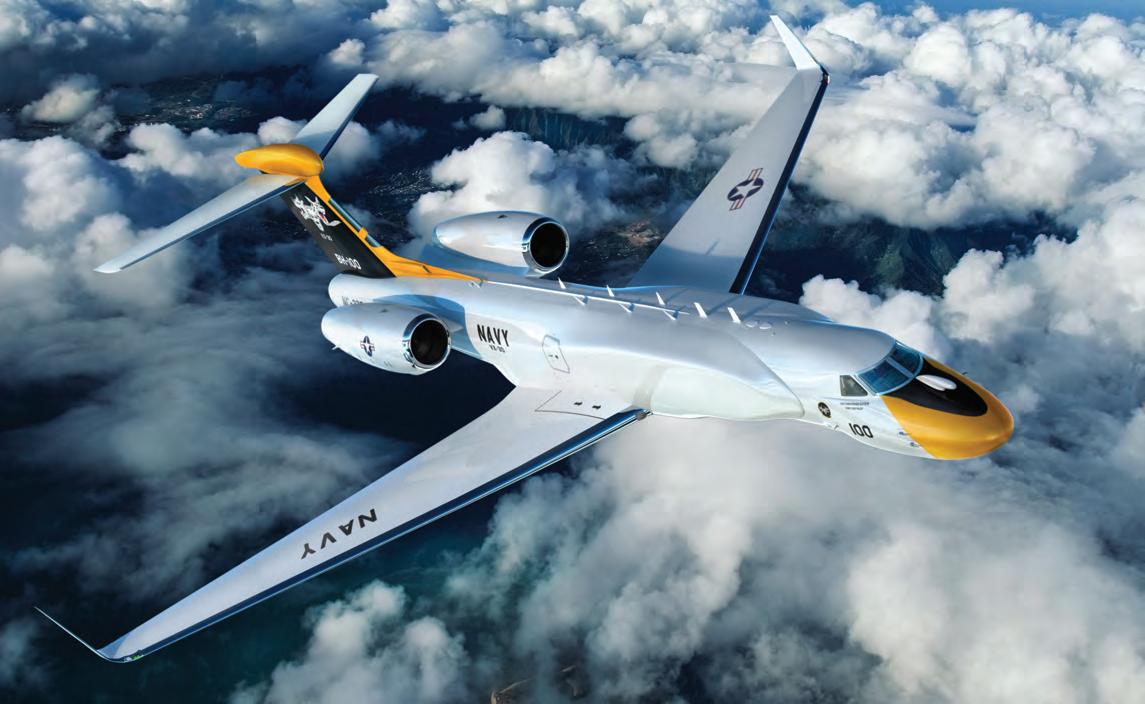
This modified Gulfstream G550 hosts a wide array of sensors to support the U.S. Navy’s telemetry range support mission.
Besides transporting business leaders and movers and shakers, business jets have found themselves an invaluable asset for another highly demanding cross-section of customers: the military.
Despite eschewing luxury in-flight hospitality, the attributes offered by these capable and customizable aircraft make them ideal candidates for military and parapublic missions, with their adoption on the rise.
The use of modified business aviation aircraft appears to be booming within the defense sector, fulfilling a variety of roles including electronic warfare (EW);
intelligence, surveillance, and reconnaissance (ISR); signals intelligence (SIGINT); and airborne early warning and control (AEW&C), among others.
As rising geopolitical tensions are augmenting demand for aircraft, air forces and operators are increasingly turning to the key capabilities specifically offered by business jets to fulfill these missions. Larger and farther-ranging than legacy turboprop fleets while simultaneously smaller than converted commercial airliners, the speed, time-to-altitude, endurance, flexibility, economic feasibility, survivability, and reliability of many proven business
jet conversions offer a “sweet spot” that many defense applications are enthusiastically exploiting.
Crucially, the development of longerrange platforms such as the Bombardier Global lines and the Gulfstream GV/550 (combined with lighter, more efficient onboard electronics and mission systems) made the business jet a more viable option within the defense and special missions sphere. However, that is just part of the story.
“Economic and national security interests are changing, and governments are increasingly seeking solutions that allow them to react quickly to events around the globe, while operating at greater distances from home bases,” explained Steve Patrick, v-p of Bombardier Defense. “This requires a new level of agility and responsiveness that was not necessary in the recent past, and this change of geopolitical reality has led to the need for capabilities over much larger distances.”
Additionally, “the requirement for defense-configured business jets has grown in scale and complexity, reflecting rising demand for persistent ISR, resilient command-and-control, and adaptable mission platforms,” confirmed Leda Chong, Gulfstream Aerospace v-p of worldwide government sales.
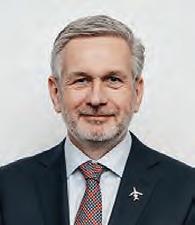
Bombardier’s portfolio of top-performing aircraft with unparalleled engineering expertise to create custom solutions for governments and militaries around the world,” continued Patrick.
Indeed, the list of Bombardier aircraft applications within this area is becoming more extensive.
Economic and national security interests are changing, and governments are increasingly seeking solutions that allow them to react quickly to events around the globe, while operating at greater distances from home bases.
This complexity represents much more than simply taking the Erieye roof-mounted “ski box” radar from atop an AEW&C-configured legacy Saab 340/2000 turboprop and bolting it to a business jet.
“In recent years…as payload and sensor form factors have reduced, along with power and cooling requirements, the host platform requirements have changed,” offered Bombardier’s Patrick.
Extensive consideration has been given to supporting the power-intensive demands of modern ISR and EW systems, providing capacity not just to run the systems but to disseminate and distribute data in real time.
The Bombardier Global G6500 is powered by the Rolls-Royce Pearl 15 engine, which “features standard additional generator capacity above and beyond the basic aircraft requirements. This excess power can be made available to accommodate mission payloads without the need for fundamental redesign of the power generation and distribution system,” he added.
Gulfstream’s Chong also believes that platform adaptation “requires more than incremental upgrades; it requires deep
integration.” Gulfstream “manages this by executing modifications in-house, with dedicated engineering and test teams that work directly on the aircraft from design through delivery. Customers are not just acquiring an aircraft but a platform engineered for their mission from thhe start.”
Bombardier Defense, which spun out as its own business unit in 2022, “leverages
Three modified Global 6000 aircraft form the basis of the Bundeswehr’s PEGASUS (Persistent German Airborne Surveillance System) project, replacing the 1960s-built Breguet Atlantique BR.1150 maritime patrol aircraft. A 10th modified Global 6000 serving as the U.S. Air Force’s (USAF) E-11A BACN (Battle Airborne Communications Node) is also set to be delivered by 2027, offering a capability colloquially referenced as “Wi-Fi in the Sky.”
Additionally, the Global 6500 is “the platform of choice for many missions because it is an in-production, commercially available solution that is well suited to modification and adaptation,” continued Patrick. To date, these include Saab’s GlobalEye multi-domain command and control (C2) platform, Sierra Nevada Corporation’s RAPCON-X (rapidly configurable) ISR solution, and
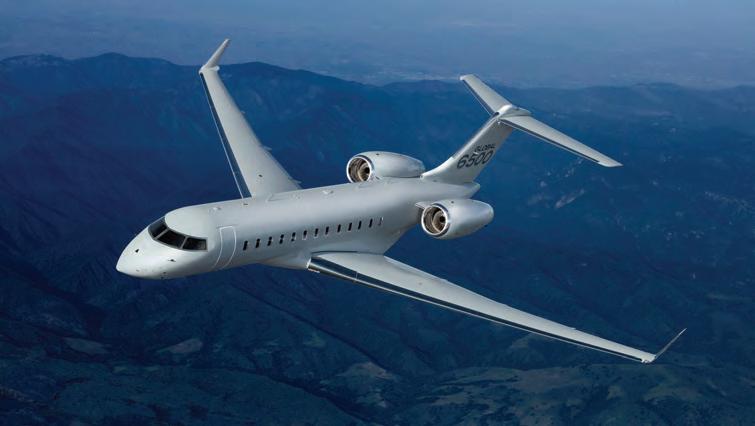
the U.S. Army’s upcoming HADES (High Accuracy Detection and Exploitation System). The latter is, itself, the successor to so-called “stopgap” capability measures, including the ARTEMIS, ARES, and ATHENA projects (also using the Bombardier Challenger 650 or Global 6500).
Meanwhile, the Gulfstream G550 forms the basis of the U.S.’s Conformal Airborne Early Warning (CAEW) aircraft and the upcoming USAF Compass Call aircraft, the latter tasked with what contractor L3Harris described as the “disruption of enemy communications, radars, and navigation systems.” Looking across all of its programs, Gulfstream has delivered more than 200 special-mission aircraft to support governments and militaries globally.
Not to be left behind, Dassault Aviation’s Falcon 8X will also form the basis of the French Air and Space Force’s ARCHANGE (Avion de Renseignement à CHArge utile de Nouvelle GEnération) strategic airborne intelligence platform, replacing the decommissioned Gabriel (a modified Transall C-160 military transport aircraft).
Regardless of the OEM, however, business jets are certainly proving their prowess within a variety of roles their legacy forebears are increasingly unsuited for. They are also helping redefine and streamline fleet sizes. As an example, the 14 modified Global 6500s forming the basis of the U.S. Army’s HADES program will replace a fleet of some 70-odd Beechcraft King Air and de Havilland DHC Dash 7 turboprops, offering extended range, reliability, and payload, with a top speed of Mach 0.90. Providing increased cruising altitude and persistence, the Global 6500’s 30% greater line-of-sight range than legacy options “enables the modern, more capable sensors to cover a wider footprint…meaning the same tasks can be completed with fewer aircraft, within a larger area,” said Patrick.
With the Global 6500 able to be positioned almost anywhere worldwide with a single refueling stop, “this translates to

Governments and militaries are looking for aircraft that deliver both strategic endurance and operational flexibility without the cost and footprint of larger converted airliners.
having the aircraft in operation anywhere within 24 hours, whereas legacy platforms… may require multiple fuel and crew duty stops,” he elaborated. The Finnish border guard has also opted to replace its legacy Dornier 228s with a pair of modified Bombardier Challenger 650s, selected for what it stated as “[extended] operating time and greater transport capacity.”
Conversely, business jets also offer a crucial alternative to the commercial airliner-sized platforms of yesteryear, such as the U.S.-Israeli-developed Boeing 707 CAEW aircraft, now superseded by the Gulfstream G550. “Governments and militaries are looking for aircraft that deliver both strategic endurance and operational flexibility without the cost and footprint of larger converted airliners,” reiterated Chong.
A spokesperson for Saab’s GlobalEye AEW&C aircraft added that “when compared to a commercial jet platform, the Bombardier Global 6500 shows tremendous advantages, including optimized turnaround, reduced training time for maintenance, and seamless training for personnel. Additionally, small platforms do not require special runways or location infrastructure and can be deployed much faster.”
This, asserts Saab, reflects its company-wide belief in developing “solutions that minimize waste and maximize efficiency while delivering optimal performance.”
The GlobalEye, first developed in 2016, is a prime example of how business jet attributes can be best harnessed to provide what the Swedish defense company described as “a compelling option for
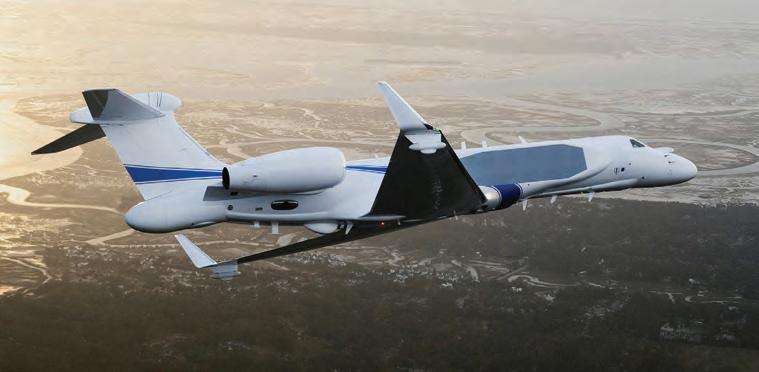

customers seeking enhanced survivability in contested environments.”
Among other interests, five units have been delivered to the UAE, Sweden has three on order, and France recently declared its intention to acquire up to four to replace its aging Boeing E3-F Sentry (also a Boeing 707 derivative).
However, despite NATO shunning GlobalEye for the larger Boeing 737-based E-7 Wedgetail, the latter program has faced its share of criticism. In June 2025, a senior USAF official referenced “significant delays with cost increases from $588 to $724m [per] aircraft” as well as “survivability concerns in this contested environment.”
“Survivability has several dimensions to it,” responded Bombardier Defense’s Patrick. “Larger platforms are easier to detect and deter. Also, platforms that must operate closer to the lines of engagement to enable sensor sight lines would be at an increased risk.”
In addition to the Global G6500’s maximum endurance of more than 18 hours and 12,223 km range, self-protection systems can also be added to further mitigate risk. Additionally, the ease and efficiency with which a platform can be maintained and sustained in operational environments is a key consideration: lessening reliance on specific logistics support chains
or significant infrastructure in underresourced territories.
“Today, we are supporting record levels of activity across our product line in missions ranging from airborne early warning to aeromedical transport,” concluded Gulfstream. “The pipeline is robust, and opportunities continue to expand.”
Dassault also estimates that 10% of its in-service Falcon jets are used by military, government, or health organizations. Augmenting the demand from returning customers, nations such as Canada are also considering AEW&C capabilities for the first time, with the ongoing Canadian competition likely
to see Bombardier and Boeing head-tohead once more.
“GlobalEye’s modular and scalable architecture allows for efficient production and customization [and] facilitates easy integration of new technologies and upgrades, ensuring the system remains relevant and effective over its life cycle without extensive modifications,” stated Saab, which is working to raise its annual production capacity to four systems a year.
Alongside perceiving a “growing demand for airborne surveillance solutions,” Saab also recognizes the importance of new technologies for airborne surveillance platforms. “We understand the future battlefield for airborne surveillance will likely be a mix of manned and unmanned solutions working together. In this integrated approach, GlobalEye remains a crucial asset, coordinating and enhancing the overall effectiveness of the defense ecosystem,” the spokesperson concluded.
Similarly, Bombardier recognizes that “emerging technologies in artificial intelligence, autonomy, and manned-unmanned teaming present powerful opportunities to enhance the effectiveness of manned ISR platforms—particularly within a system-ofsystems framework that emphasizes integration, adaptability, and mission agility.” z
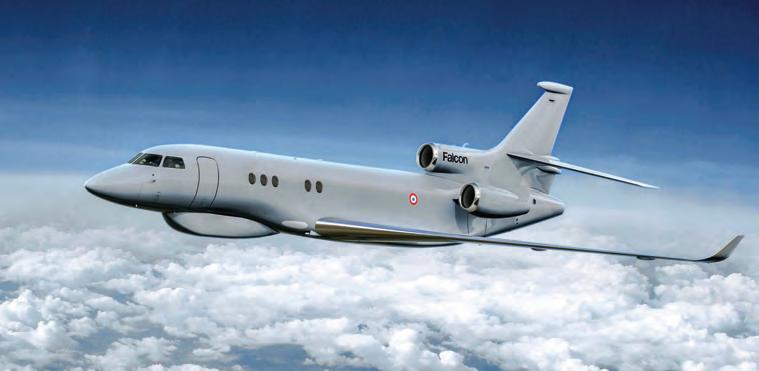
BY JULIE BOATMAN

Wading through a pile of discarded charts between the bookcase-like stacks of them marked my first day at Jeppesen, back in August 1997. I was on the official tour with another new colleague who would remain a friend—Mike Pound. He went into the communications division, while I joined the Guided Flight Discovery (GFD) editorial team in Aviation Courseware Development (ACD).
ACD was the offspring of Sanderson Films, the aviation training materials provider that became the latter half of
Jeppesen-Sanderson, for those who recall the marriage and its hyphenated liaison. My first remit was to write chapters for the GFD Instrument-Commercial Manual, incorporating all of the then-new technology, such as in-panel TSO’d GPS units, for example, the BendixKing KLN 94, and the first digital charts, which Jeppesen’s Nav team was busy bringing to life and delivering to electronic flight bags (EFBs).
Now, I know this all makes me a relic to many readers. But it was an exciting time,
because the visualization of the aircraft’s position in space was on the cusp of leaving the abstract and becoming a picture displayed for the pilot on a screen in the cockpit. Where we once took info from a scan of analog “round dials,” engine instruments, and VOR, ILS, and ADF needles, we suddenly had a GPS-generated fix and the sighting of our position, the first “ownship”—at that time, just a moving dot on the tiny display.
For the GFD ICM chapter on aeronautical decision-making that I was tasked with
writing, I recall vividly sketching out three layers of information for an illustration of the components to that visualization process: the underlying terrain, the aircraft in space along an airway between fixes and/ or VORs, and the heading, altitude, airspeed, and attitude data. What I was trying to get the pilot to do was to think of themselves in three dimensions and picture it in their mind.
Flash forward 28 years, and we have multiple ways of obtaining that visualization for us on either flight deck multifunction displays, or in the palm of our hand on an iPhone or iPad running one of two popular apps: Garmin Pilot and ForeFlight.
Both have launched significant situational awareness tools over the past few years, but the latest version of Garmin Pilot was first out of the gate this summer, taking intelligent digital charting to the next level.
With SmartCharts, Garmin builds on a strong portfolio of ever-improving tools on the ground and in the air—such as SafeTaxi, which has been reminding me of runway crossings for several years now.
The pilot taps into SmartCharts starting in one of two places on the Garmin Pilot app. The first path is via the Airports tab under charts at the top, where you need to ensure you have the SmartCharts option selected.
Or you can begin within the chart section, where charts can be stored along with other flight planning elements in a Smart Binder for that flight. Charts are grouped according to type (approach, arrival, departure, or airport info) for another way to streamline the selection process and go right to the phase of flight you’re searching for.
For demonstration purposes,the easiest way in is the Airport tab, where you can start by reviewing the airport diagram. This is where the expansion to SafeTaxi
ground operations functionality—as you’d see in the GTN 750 or integrated flight decks—becomes apparent, with added features including airport lighting systems, hold short lines (and other aircraft markings), windsock locations, and hot spots highlighted for that airport.
The goal was to pack all of the relevant information onto one page to reduce the amount of flipping back and forth to glean the critical information—such as noise abatement procedures—that might otherwise be missed. Other information under the “Operational” header pulls details from the airport/facility directory. Notams are found elsewhere along the top of the airport page, or on the map page in the lower right corner of the plan view.
From the airport page’s Runways tab, you can select the runway you plan to use from a list for its specifications and
any notes, and on the Charts tab, you can preview any of the instrument approach procedures. The “Show with Minima” procedure sorting feature allows pilots to identify approaches by the lowest minimums available, for example, and approach lighting. Rather than having to guess at which approach would deliver the lowest legal minima, pilots can have the app deliver procedures sorted in that order, saving time.
You’ll first sort these by aircraft category (A through E or Heli A) and, at a glance, see the decision height or MDA, visibility minimums, and what lighting system to watch for out the front window (with any luck). There’s even one more “smart” detail built in: since most general aviation pilots flying with Garmin Pilot use aircraft in Category B (90 to 120 knots), that’s the default as opposed to Category A (less than 90 knots).

You can also sort by the need for altimeter setting, inoperative lighting, or flight director or HUD considerations.
The part I think most pilots will find beneficial starts when you select an approach to brief from the list. Garmin has been able to take a lot of data—its proprietary database, by the way—and declutter it so that we see only what we need for a specific trip and instance.
The app displays only the waypoints, crossing restrictions, and segments relevant to the procedure and entry point and method, clearing up the display and highlighting important notes that might otherwise get lost in the crowded chartspace. You obtain this by selecting the transition fix in the drop-down, with initial approach fixes denoted with an “i” ballflag.
COMs, Brief, and Missed (approach) buttons take you right to that information so you can set up and brief the approach quickly and accurately. The Brief button brings up a dedicated box, so instead of making your approach briefing feel like an IFR knowledge test, you get just the info you need, and you don’t have to go hunting for arcane details—and that could cost lives if ignored or missed.
find in the Notes section on the chart. It shows you if you can’t do the procedure at night, or if you don’t have current ATIS information, you’ll need to increase your minimums by 50 feet. So now, instead of having to sit there with a piece of scratch paper while flying in the clouds, you can click on one button and it automatically updates those details.
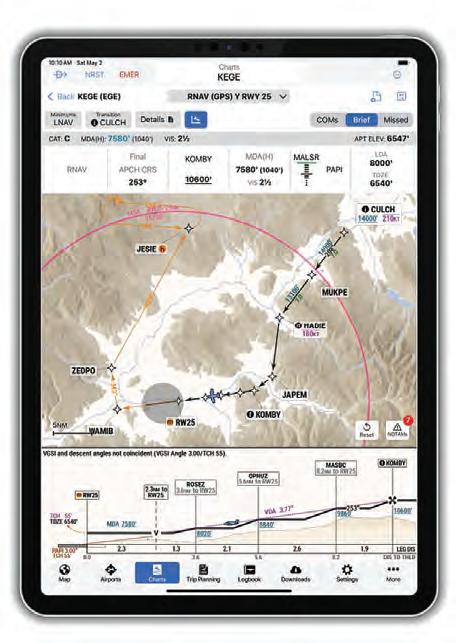
This is especially true when things change during the last segment of a flight, and you can drill quickly to the fixes you need to cross, and the altitudes and speed(s). Critical details such as decision altitude/height, MDA, and required visibility stay at the top of the chart for quick reference based on the category, again, and whether it’s a circling approach.
Further refinements are found under the Minimums tab on the top left, and the Adjustments field at the bottom of the popout box. This is for the stuff you’d normally
At any time, if you want to refer to the chart itself, the digital AeroNav (FAA) chart pops up for review. This keeps the base map free from the chart itself, which, depending on your preference, you may find useful or distracting once you’re comfortable finding all of the info on the SmartCharts layout and menu system.
As you’re using the SmartCharts function in flight, you will see several cool features, including the superimposing of the minimum safe altitude range ring on the map, centered on the airport for reference.
If you’re flying a circling approach, you can view the circling range arcs based on your aircraft category—and instantly see which obstructions or terrain sit near those arcs, for an additional level of situational awareness. You’ll also see, when zoomed out, both magenta and cyan highlighting on points where there is more detail available when you zoom in. This helps keep you from missing key bits of info.
Another real wow feature? For me, it has to be the first-in-the-industry geo-referenced profile view with an active ownship. Your approach path pops onto the profile view once you load the approach with the selected IAF or transition.
In practice, the actual blue aircraft icon may show as below the glide path when you’re on target because Garmin’s engineers coded the position using GPS data from the tip of the aircraft’s nose as opposed to a central point. The reasoning was to place the POV from the flight deck— and it shows off the incredible accuracy of today’s GPS. One note: if you use baro-nav in your airplane, it may register differently from our discussion here.
SmartCharts are available now through a Premium Garmin Pilot subscription, for the U.S. and Bahamas, on iOS devices, currently $209.98 per year. One license allows an individual to use the Garmin Pilot mobile app on up to three compatible devices. Each licensee can choose their device platforms and types. Unfortunately for Android users, that device’s app version does not yet support SmartCharts. If you want to try it on for yourself, Garmin has made a free trial available to all pilots at garmin.com/ aviation/garminpilot/downloads. z
BY KERRY LYNCH

Recently named Vertical Aviation Association (VAI) president and CEO François Lassale anticipates stepping into his new role with plans for a fast start and ambitions to elevate the organization on an international stage and across vertical lift.
When AIN interviewed Lassale in late August, he was transferring to Alexandria, the home of VAI, from his base in Bali, Indonesia, where he was CEO of a group of three companies—SGi, HeliNiugini, and Allway Merit— steering both helicopter operations and the aircraft leasing business.
“I’m super excited about the opportunity, to be honest with you. I think we’re going to do some great things,” Lassale told AIN. “We’ve done the rebrand now, so now is the time to put our foot down and keep going and integrate this universe that’s evolving around us.”
Lassale, who succeeds James Viola as president and CEO, is bringing deep experience to that role, having a 35-year background working with numerous civil and commercial fixed- and rotary-wing operations, along with the Royal Air Force. He also brings substantial advocacy experience, having held leadership positions with HeliOffshore and working with the Flight Safety Foundation and NBAA.
He has already been closely tied with VAI, having served as a special advisor to the board on international issues. In particular, he has dived into strategy in Southeast Asia.
“I’ve worked with the board and the team over the last 18 months to try to pull together the resources and the community for our first Southeast Asian safety conference,” he noted.
That event is planned for May 27 to 29, 2026. “We’ve got a lot of interest in the
local community,” he said, and explained that the conference came about after he was asked to serve as a keynote speaker at a Bell reception before the wider helicopter community. He discussed pain points, the lack of advocacy, poor safety, poor oversight, and the lack of representation.
Following that, he noted that many of his competitors and other industry members wanted to become involved.
“When you look at the numbers about the expansive and explosive growth in this part of the world, it made sense to start it here and then build this out into a proof of concept that we can cut and paste into Africa, the Middle East, and South America,” he said.
The VAI board embraced the idea and greenlighted the regional effort. “I’ve been pursuing that as my role as international
advisor on the board. Now that I am stepping into this role, I’m excited to take that further.”
However, while the selection of Lassale may be a clear signal of VAI’s international ambitions, he also has an equally clear vision of the needs of the U.S. domestic community.
“When I was invited onto the board as an international advisor, I wanted to see what tangible value proposition we can bring to our constituents and members across 77 countries worldwide,” Lassale said. “Now, obviously, as I’m an international person joining the VAI team full-time, there are some people questioning whether that would detract or dilute what we’re doing in the U.S., because it is the biggest part of our membership and our constituents. My answer to that is no, absolutely not. We will continue what we’re doing.”
He continued, “Actually, we’re doubling down on some of the advocacy.” He pointed to last year’s passage of the FAA reauthorization and talk of the administration about advanced air mobility. “They’re driving hard and fast on that,” Lassale maintained. “Whatever happens at an FAA level, certainly in rulemaking, we can advocate and have some influence, and there is a trickledown effect internationally.”
To Lassale, this means playing a role in guiding the domestic agenda and spreading that globally through a network of conferences, summits, shows, and other means. He sees substantial opportunity, particularly on the safety and data side.
Noting his time with HeliOffshore, where he held roles as operations director, COO, and CEO, Lassale said those efforts were a driving force with that organization. “We had done a lot of work with a lot of very experienced and qualified people in flight path management, health and usage monitoring, flight data monitoring, and flight
path guidance. I had the resources with the oil and gas industry to do that,” he said. “I want to try to get that into the four corners of the world.”
His plans are to spread work on such programs out to the broader community and “really to drive that change across the industry.”

FRANÇOIS LASSALE CEO, VERTICAL AVIATION INTERNATIONAL
These changes are particularly critical now as the community is expanded, Lassale added. “That’s why when this [role] came up, a move from Bali was a big step, but I was like, ‘How exciting is this? To play a role in being able to shape a whole industry right at an inflection point where you’ve got AAM coming in and how we bring all of that together.’”
He said the timing is perfect to tie it all together, just as Vertical Aviation International has completed its rebrand from Helicopter Association International. “We sit at this inflection point now as an industry where certification of this equipment is coming. It’s here,” he reiterated. However, Lassale stressed that the goal is not to try to be everything to everybody. “That’s not going to work,” he said. But the goal is to define what is ahead for the community, working with the AAM market. “If we don’t define it, somebody else will. It’s about keeping our relevance.”
What this means, he continued, is “we recognize as an organization that we need to be inclusive. We need to bring the communities together. We operate in the same airspace.
We have a lot of cross-pollination in our DNA. We’re going to have a lot of cross-workforce flow, from helicopters into eVTOL aircraft and the other way around. We need to support the development of that infrastructure. We need to stare down the barrel of the workforce shortfall coming in 10 years. These are things that we need to position ourselves behind—we take the lead on it and drive that change and bring the community together.”
This is particularly important as the industry has waged a seemingly neverending battle on the public perception front, particularly with safety.
“Safety is the currency to credibility for us as an industry—whether we’re actually owning that,” Lassale said. “We’re taking responsibility for it as an industry.” Noting the integration of the new technologies, he said, “A lot of people think it’s a dystopian future. It’s not. These aircraft are here; they’re being certified. By integrating that community, it helps us deliver a more unified voice.”
A key to all this is data, and Lassale stressed this will be a driving priority. “If we use data and get the data into all the lawmakers’ hands, it adds credibility to what we are doing.” He pointed to efforts in the offshore oil and gas industry with HeliOffshore. “We managed to build the ability for operators to benchmark themselves against the industry and then lobby the EU and the states because we had data. That’s going to be a drive of mine to formulate that platform.”
He said the data demonstrated that “we were saying that we’re building our flight safety roadmap, and we worked very closely with EASA to influence that because we had the data to do it.”
But it also had a wider message: “It helped us lobby governments about the value of vertical lift, and why it’s important, what we do, how many barrels of oil [we support], how many lives we saved, how many fires we extinguished, and how many places we build. It’s data that will give us that credibility on multiple levels.”
Not only is having data in hand helpful in the court of public perception, but also in demonstrating the value of safety programs and equipage efforts to the operators.
“Under the FAA reauthorization, there is a focus on trying to drive safety enhancements. That’s going to come at a material cost to the industry. Using data shows why it’s important,” Lassale maintained. “The technology is there. It’s much more affordable now, and we need to work with the community, the FAA, and Congress to help drive that change.”
He said the data will showcase “what’s in it for me? What’s the value proposition?”
This is important given the Part 135 safety management system (SMS) mandate with other programs such as fatigue mitigation and flight data monitoring. “All these things cost money.”
Also, to help demonstrate the value proposition, the community needs to work with manufacturers on cost-effective solutions and with regulators to ensure there is flexibility and rules aren’t draconian, he said.
Even so, Lassale believes that the Part 135 community has grown in its acceptance of SMS. “In the international market, I think it was more accepted than in the domestic market for a long time, since it wasn’t regulated to that degree. But that regulation has come down the pipeline, and I think there’s more acceptance of it.”
Lassale stressed the importance of small operators to the association, since they comprise the majority of the membership.
“The key with small operators is to listen to them. It’s important that they feel validated. They’re looking for a trusted advocate, not just in Washington but worldwide.”
He also has a vision that VAI could serve as a community support platform whereby operators could anonymously submit questions surrounding problems they encounter, and other members of the community could share their experiences.
VAI should be a unifying voice spanning both the helicopter and AAM world, but the
small operators probably have questions about whether the latter “is coming to take our jobs…That is genuinely a concern.”
One way to address that is with unified, internationally recognized recommended practices. “That’s such an important thing,” he said. “We currently have about 17 different standards in the helicopter industry, which is crazy.”
These efforts are key to broadly elevating safety. Lassale pointed to high-profile accidents such as the January midair collision of a U.S. Army Black Hawk and a Bombardier CRJ700 over the Potomac River, the Bell LongRanger crash into the Hudson River, and the midair collision between two Airbus EC130B4s in Australia, and said, “Absolutely every single one of them could be avoided.”
But he added, “Living and working down here in this part of the world, and it’s no di ff erent in Africa or South America, for every one of those high-profile ones, there’s probably four or five similar
accidents where there is poor decisionmaking, poor oversight, poor maintenance, and poor knowledge base.”
While Lassale was awaiting his new role, he spent the last few months hashing out his internal 90-day plan “so when I hit the ground, I hit the ground running, and then I can start the external part of my 90-day plan, which is to do a lot of collaboration with all the other stakeholders in the industry, listen to our members, to the board, to constituents, and obviously to the internal team.”
He acknowledges that some of his plans are not going to be easy. “You probably have some of the naysayers still out there who [believe] it’s all nonsense. I don’t believe that’s the case at all,” Lassale said. “For me, it’s not old versus new. It’s tried and tested versus promising up-and-coming aviation, which we then integrate together because they go hand in hand; they don’t sit apart. So, for me it’s a really exciting opportunity.” z

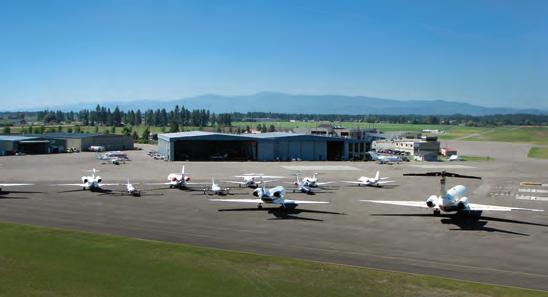
Atlantic Aviation has expanded its FBO network with the acquisition of Glacier Jet Center (GCI), the lone service provider at Montana’s Glacier Park International Airport (KGPI) for nearly half a century. The FBO has a 10,000-sqft terminal with a galley, eight-seat conference room, pilot lounge, flight-planning area, concierge, and crew cars. It is also adjacent to the airport’s U.S. customs facility.
The complex features 10 acres of ramp and more than 175,000 sq ft of heated hangar space capable of sheltering aircraft up to a Bombardier Global 6000. Its fuel farm has a capacity of 137,000 gallons of jet-A and 24,000 gallons of avgas.
For Atlantic, this represents its 106th location in the U.S. and Caribbean, and its first in Montana.
Yellowstone Regional Airport (KCOD) in Cody, Wyoming, has welcomed a second aviation services provider with the opening of the Beacon Air Group FBO. For Beacon, this marks its second location, having opened its first FBO in Billings, Montana, in 2023.
At KCOD, the company refurbished and upgraded an existing 3,000-sq-ft, pet-friendly terminal, offering concierge service, passenger lounge, 20-seat conference room, business center, crew car, and vehicle parking.
A gateway to Yellowstone National Park, the FBO also has a 9,000-sq-ft hangar that can accommodate aircraft up to a Citation Excel; through agreements, it can provide shelter for larger midsize business jets. Company owner Joel Simmons told AIN that he is now exploring opportunities for additional development on the field, including a hangar capable of housing large-cabin private jets.
As an Avfuel-branded facility, Beacon participates in the fuel provider’s Avtrip customer loyalty programs, as well as contract fuel pricing.
Cunningham Aviation’s FBO at Falcon Field Airport (KFFZ) in Mesa, Arizona—opened since 2021—has strengthened its position there with the acquisition of rival Avflight Mesa’s assets. The move brings the number of service providers at the airport to two.
Included in the purchase is Avflight’s former 7,000sq-ft terminal on the north side of the field and a 10,000-sq-ft hangar capable of sheltering the latest ultra-long-range business jets. Company founder and president George Cunningham told AIN he plans to continue to maintain and operate that facility, along with his existing 6,000-sq-ft terminal and 30,000-sq-ft hangar, which can accommodate turboprops and light jets.
Cunningham also added Avflight’s fuel farm with a capacity of 20,000 gallons of jet-A and 25,000 gallons of avgas. This more than doubles its previous fuel capacity at KFFZ.
As a result of the deal, Cunningham will transition to Avflight’s sister company, Avfuel, as its fuel supplier.
Oklahoma’s Miami Regional Airport (KMIO) has inaugurated the new terminal for its municipallyoperated FBO. The cost of the $3.28 million project, which began last year, was split roughly evenly between the Oklahoma Department of Aerospace and Aeronautics (ODAA), the FAA, and the city of Miami.
It included a 4,000-sq-ft terminal with a passenger lobby, pilot lounge, showers, 16-seat conference room, landside porte-cochère, and outdoor observation patio. The new facility replaces the earlier 1970s-era terminal, which is attached to a 4,800-sq-ft hangar and will be repurposed as tenant offices.


Corporate Angel Network (CAN) provides cancer patients free seats on jet and turboprop business aircraft to treatment throughout the United States.
anks to the generous support of our partners, CAN has coordinated more than 69,000 patient flights. Can you spare an empty seat or donate to our mission? e space you fill may well be in your heart.

MRO services provider StandardAero recently celebrated the grand reopening of its expanded business aviation facility at Georgia’s Augusta Regional Airport (KAGS). The project, which took a year to complete, added 80,500 sq ft of hangar space, an engine shop, advanced avionics repair capabilities, and customer amenities, increasing the size of the facility by 60%. According to the company, the expansion specifically targeted an increase in MRO capacity for the Honeywell HTF7000, for which StandardAero is licensed by the manufacturer as the exclusive independent heavy overhaul provider, along with additional airframe service capability for large-cabin business jets.
ACI Jet, based at California’s San Luis Obispo County Regional Airport (KSBP), has received EASA Part 145 maintenance organization approval, allowing the facility to work on European-registered aircraft. The certification also expands the company’s AOG support capabilities for European-registered aircraft.
The process required more than a year of preparation, documentation revisions and submissions, and audits, with the FAA FSDO providing guidance, according to ACI Jet quality control manager Isaac Garner.
EASA’s blessing adds to the Bombardier-authorized MRO’s recent Part 145 certification by the Civil Aviation Authority of the Cayman Islands. It also holds maintenance approvals from the FAA and Transport Canada and is seeking to add similar nods from Mexico’s AFAC and other international aviation regulators.
Germany-based MRO provider and aircraft operator Atlas Air Service has partnered with FTI Engineering Network to
earn an EASA STC for the installation of the Gogo Galileo HDX system and Avance SCS router in the Cessna Citation CJ1+. This is the second STC for the Galileo HDX install that the companies have received over the past year, with the first being for the Embraer Phenom 300 in January.
The General Electric CF34-3B, which powers more than 300 in-service Bombardier Challenger 604s, is the latest addition to Engine Assurance Program’s (EAP) hourly engine maintenance program. Also covered in the company’s service offering are the GE CF34-3A/-3A1/-3A2 engines on the Challenger 601 series.
EAP’s plan provides service for a range of legacy business jet engines from Honeywell, Pratt & Whitney Canada, and Rolls-Royce, in addition to GE Aerospace.
By owning the spare parts inventory as well as its own rental engines and APUs, EAP says it is able to mitigate the supply-chain issues that have tested the industry of late and provide proactive customer service. Engines under the company’s care have a 99.98% dispatch reliability rating.
Embraer has named Aerocardal as an authorized service center in Chile. Based at the Arturo Merino Benítez International Airport in Santiago, Aerocardal will provide line maintenance services for the Embraer Phenom 300, including unscheduled maintenance, AOG support, and drop-ins for customers operating in the country.
In addition to Latin America, Embraer recently doubled its executive jets MRO capacity in the U.S. with new maintenance lines in Dallas, Cleveland, and Sanford, Florida. The company has nine owned service centers dedicated to its executive jets.
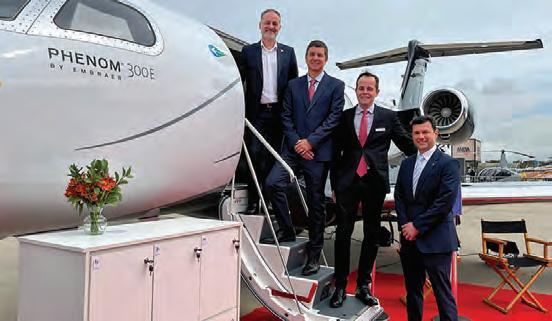
While still less than two years old, Jets MRO, a maintenance provider at Dallas Executive Airport (KRBD), aims to make waves in the industry, with a new technician-first approach. It was founded by Suresh Narayanan, a former executive with JSX, who believes that with his operator experience, he brings a di erent perspective to the general aviation MRO industry.
He observed during his tenure with JSX that, oftentimes, aircraft were delivered later than promised from maintenance. “I realized the biggest issue was mechanic turnover, and the average experience was going down even though they were replacing headcount; these MROs are losing experience,” he noted.
Narayanan surveyed thousands of aircraft mechanics before he opened his facility to determine why they leave employers. While it was generally believed the most important concern for them was salary, he found instead business culture, engaged leadership, benefits, and schedule topped the list.
“If I can fix this starting with [putting] mechanics first, we can win because a happy mechanic produces a better aircraft on time, that’s the whole concept, that’s the value proposition.”
To achieve this, Narayanan implemented several employee-friendly policies, including free benefits, no mandatory overtime, and a four-day work schedule, with overlap between the two shifts on Thursdays, given that the business operates seven days a week.
Once a month, in the interest of transparency, he shares the company’s financials and answers any employee questions.
In terms of staff, Jets MRO currently has nearly 40 technicians at KRBD and is actively seeking experienced talent. “Last

Jets MRO opened its 40,000-sq-ft Dallas Executive Airport facility less than a year ago.
year was hard because nobody had ever heard of us,” explained Narayanan. “This year, it’s getting easier every month, I think because we are focusing on the right things. Our current team is the best recruiters.”
His near-term goal is to reach 50 mechanics, with a plan to add two experienced technicians a month. “If I could grow faster, I would," stated Narayanan. “We have a new hire starting every other week for the most part.” Eventually, he wants his facility to be operational 24 hours a day with a sta of 100. “Dallas is the number one concentration of A&P mechanics, so the talent is here,” he said.
The company occupies a 40,000-sq-ft hangar in the new Jet Access FBO facility on the west side of the field. The hangar was built from the ground up as a maintenance facility, and Narayanan and his staff had input in its design as it took shape. Before the new hangar’s completion, the maintenance provider briefly occupied an old hangar on the opposite side of KRBD.
Jets MRO holds an FAA Part 145 repair station authorization and specializes in
small to midsize jets. “We can do heavy D-plus inspections on (Bombardier) Challengers, (Cessna) Citations, Hawkers, Lears, and Beechjets,” Narayanan said, adding Part 135 operators and their scheduled aircraft maintenance make up the bulk of his customer base. “All the heavy checks on them, gear changes, engine changes, nothing is o the table.”
With a mobile repair team based at Dallas Fort Worth International Airport (KDFW), the company will also do AOG response within a 100-mile radius.
While it has been in its new home for less than a year, Jets MRO has already had 12 light to midsize jets in its hangar at the same time, and the company is booked out to three months. “Last year, because we were new, it was month-tomonth, and year two, people are learning about us and we’re getting recurring business, so it’s booking out longer,” Narayanan stated. “I just want to keep my guys busy, and if we can make a little money, give them consistency and hit the things that we want to, that’s what we consider a success.”
C.E.
BY DAVID JACK KENNY
Cessna 425, July 17, 2025, Round Rock, Arizona
About 1.5 hours into an instructional flight from Denver, Colorado’s Centennial Airport (KAPA) to Phoenix, Arizona Deer Valley Airport (KDVT) at FL260, a loud noise from the left engine was followed by “an immediate and total loss of engine power.” The right engine then lost power while the pilots attempted to troubleshoot the left. They declared an emergency and attempted to restart the right engine, only to experience a complete electrical failure. Both pilots escaped without injury after a forced landing in open desert that separated the main landing gear and caused substantial damage to the left wing.
Piper PA-46-500TP, July 20, 2025, Lititz, Pennsylvania
The instrument-rated private pilot was killed when the single-engine turboprop abruptly pitched down and crashed just after takeoff from Runway 08 at Lancaster, Pennsylvania Regional Airport (KLNS). The IFR flight’s destination was State College Regional Airport (KUNV), also in Pennsylvania. Line personnel at KLNS pulled the airplane from its hangar and topped it off with 74 gallons of jet-A before the pilot’s arrival. He reached the airplane shortly after and performed a short preflight inspection, started the engine, and correctly read back his IFR and taxi clearances.
Following a three-minute wait for IFR release, he was cleared for takeo ff. Preliminary ADS-B data showed that as the
airplane climbed through 650 feet passing the runway’s departure end at a ground speed of 136 knots, it abruptly pitched down, descending at 1,600 feet per minute. Nine seconds later, it crashed into a corn field one-quarter mile beyond the threshold. The estimated time from liftoff to impact was just 20 seconds. The estimated angle of impact was 39 degrees.
The fuselage came to rest 164 feet beyond an impact crater measuring 11 feet long, six feet wide, and 20 inches deep. The propeller was found 60 feet forward and to the right of the crater and exhibited rotational damage, including the separation of one of the four blades and midspan fractures of two others. The left wing also separated and was fractured into multiple pieces. There was a strong aroma of jet fuel throughout the debris field, with fuel blighting on the corn stalks.
Prevailing weather included three-knot winds from 200 degrees with five miles of visibility in mist under layers of broken clouds at 400 and 900 feet. Press reports described the pilot as a physician with “decades” of flight experience, who was also vice president of the Northeast Chapter of the Flying Physicians Association. His most recent third-class medical application listed 2,350 hours of flight experience.
Hughes 369D, Aug. 7, 2025, East Alton, Illinois
The pilot and lineman working to install orange marker balls on a power line spanning the Mississippi River were killed when their helicopter crashed onto the deck of a moored barge, sparking a fire that consumed most of the aircraft. A witness on the barge’s tugboat reported that the lineman was standing on the left skid, secured by a safety harness, as he attempted to attach the marker. On the second approach,
the helicopter’s tail appeared to strike the line, causing a partial separation of the tail boom. The helicopter then swung until the front fuselage hit the wire, causing a shower of sparks, and then crashed onto the barge. One main rotor blade was found about 150 feet from the main wreckage; a 7-foot section of a second blade was found 176 feet away. The remaining main rotor blades and the aft section of the tail boom, including the tail rotor, were not located and are presumed to have fallen into the river. Investigators plan to conduct a search of the river bottom using side-scan sonar.
Gulfstream 695A, April 11, 2023, 55 km southeast of Cloncurry Airport, Queensland, Australia
The operator of the Turbo Commander that was destroyed after an uncontrolled descent from FL280 was found to have repeatedly failed to formally log known defects in the pressurization systems of the accident aircraft and others of similar models, and did not “communicate it to the safety manager, undertake a risk assessment of the issue, or provide explicit procedures to pilots for managing it.”
Instead, they continued to operate the aircraft, relying on short descents to lower altitudes and use of the emergency oxygen supply to fly at altitudes where pressurization or supplemental oxygen was required. Analysis of the pilot’s recorded communications with air traffic control showed “significant and progressive impairment… [that] included errors, slowed responses, misarticulations, and eventually a failure to respond,” indicative of the pilot’s incapacitation by hypoxia.
The crash occurred during the cruise portion of an IFR flight from Toowoomba to an area north of Mount Isa where two cameramen were to perform line scanning of fire zones north of the peak. Forty-five minutes after takeoff the pilot requested and received clearance to descend from FL280 to FL150, where it remained for six minutes before returning to FL280. About one hour later, with the airplane level at FL280, radio contact was lost and the flight began to stray from its assigned route. Multiple attempts to re-establish it, including using alternate frequencies and relaying messages via other aircraft, were unsuccessful.
After nearly an hour ATC reached the pilot via his cell phone and found his speech “slow and flat.” Radio contact was made 10 minutes later and the pilot asserted that the airplane’s pressurization system was functioning normally. His communications, initially “clear and concise,” began to slow again during the next 10 minutes, and he misidentified Mount Isa first as “Ball” and then “Gordon.” He did not respond to the next frequency change, and no further transmissions were received.
Four minutes later the airplane began to slow from 236 knots without descending. At an airspeed of 138 knots it departed controlled flight, entering a tight counterclockwise turn at an increasing rate of descent. As it passed through 10,500 feet, its flight path changed to a clockwise helical descent consistent with an aerodynamic spin, maintaining an average descent rate of 13,500 feet per minute until impact.
Pilatus PC-12, Jan. 16, 2024, Saint-Barthélemy
A lower-than-recommended altitude in gusty winds led the left wing of the singleengine turboprop to strike trees on final approach to the famously challenging Runway 10 of Saint-Barthélemy Airport (TFFJ).
The ferry flight from Puerto Rico’s Luiz Munoz de San Juan International Airport
(TJSJ) crossed the Col de la Tourmente, the highest terrain under the approach path, within 16 feet of the ground, when turbulence caused a sudden left roll. The left wing sheared tree branches on the summit; right aileron input by the pilot flying then brought the right wing within seven feet of the ground. The pilot subsequently landed without further incident.
Saint-Barthélemy’s single runway is oriented 10/28 and measures 646 by 18 meters (2,119 by 59 feet) with a 2% downslope on Runway 10. Access is restricted to authorized pilots flying aircraft with approved landing performance. The Runway 10 approach requires a steep descent to the threshold after crossing the 130-foot Col at or above 155 feet. Data recovered from the onboard Garmin navigation system showed that the accident flight may have been as low as 140 feet at that point.
Fairchild SA227-DC, Aug. 12, 2024, Perth Airport, Western Australia
The limited experience of the trainee first officer led the captain to assume the duties of both pilot flying and pilot monitoring after a hydraulic system failure. The charter flight from Forrestania was about to initiate its descent to Perth when first the right and then the left hydraulic pressure annunciators illuminated. The captain requested holding vectors; during the hold, he calculated the approach speed and distance required for a no-flap landing and supervised the first officer’s performance of a manual gear extension, which uses pressure from the accumulators of the braking system’s separate hydraulic circuit. He also requested a tug to pull the aircraft to the ramp.
After landing safely on Runway 24, the captain stopped the airplane on Taxiway A. Unable to see the tug or establish direct communications, he tested the brakes, detected some effectiveness, and chose to taxi to the ramp unassisted. Approaching their hangar, the airplane picked up speed
on a slight downslope; both pilots applied full braking to no effect. The captain briefly engaged reverse thrust, then shut down both engines and feathered the propellers. The right wingtip and propeller struck the hangar. There were no injuries to either pilot or any of the four passengers. The hydraulic failure was traced to a stress crack in the hydraulic line’s union flare.
De Havilland Canada DHC-6-300, Oct. 19, 2024, Kairik Airport, Papua New Guinea
The pilot’s overcorrection after misaligning the nose wheel before the takeoff run led the twin-engine turboprop to depart the left side of the runway and run into a drainage ditch, striking the left wing and pivoting the airplane until the nose struck an embankment. Both pilots and all three passengers evacuated the aircraft without injury after the pilots shut down the engines.
The Accident Investigation Commission (AIC) found that following a tight 180-degree turn from the taxiway to Runway 05 using the tiller, the pilots advanced the throttles for takeoff without making a 3-meter (10-foot) forward roll at taxi speed to confirm the nose wheel’s alignment with the runway centerline required by the manufacturer. Initially, the Twin Otter veered right. The crew responded with both left rudder and asymmetric thrust, overcontrolling the aircraft into a sharp left turn. They unsuccessfully attempted to stop the airplane using both braking and reverse thrust as it departed the runway onto wet grass. It came to a stop following the collision with the embankment.
The AIC found that the operator’s standard operating procedures did not include the forward roll nosewheel alignment check that was mandated by the manufacturer. In addition to correcting this discrepancy, their recommendations to the operator had included “improved flight crew training and CRM currency.”
z
BY GORDON GILBERT
The U.S. Department of Transportation (DOT) proposes to amend its drug-testing program to add fentanyl (a synthetic opioid) and norfentanyl (a metabolite of fentanyl) to its drug testing requirements that apply to certain commercial transportation workers, including pilots and other airside and groundside employees. The proposed rulemaking would harmonize the DOT’s rules with those of the U.S. Department of Health and Human Services’ mandatory guidelines for federal workplace drug testing programs. “Adding fentanyl and norfentanyl is also in the interest of transportation safety, given compelling information regarding the number of overdose deaths in the United States involving fentanyl,” said the DOT. Comments to this notice must be submitted by Oct. 17, 2025.
Oct. 6, 2025
The FAA and TSA propose regulations to enable the operation of unmanned aircraft systems (UAS) at low altitudes beyond visual line of sight (BVLOS). The proposed rules are necessary to support the integration of UAS into the national airspace system. They are also intended to provide a predictable and clear pathway for safe, routine, secure, and scalable UAS operations that include package delivery, agriculture, aerial surveying, civic interest, operations training, demonstration, recreation, and flight testing. The TSA proposes to make complementary changes to its regulations to ensure it can continue to impose security measures on these operations. Comments are due by Oct. 6, 2025.
Oct. 10, 2025
U.S.-based repair stations must comply with the current version of the FAA/EASA Maintenance Annex Guide to obtain EASA Part 145 approval. The latest revision of the guide requires that, effective Oct. 10, 2025, U.S.-based repair facilities implement an FAA-approved safety management system (SMS). The SMS must be integrated into the repair station’s procedures and processes, support the Guide’s special conditions and,
as a minimum, include the requirements outlined in the FAA SMS voluntary program. To receive initial or continuous approval, the SMS application to EASA must show that it is appropriate for “the size, scope, and complexity of the repair station’s operations.” Operators unable to meet the compliance deadline of Oct. 10, 2025, have an additional two months to comply if there is a declaration included in their supplemental documents stating that they will be in compliance with all SMS requirements no later than Dec. 31, 2025.
Oct. 27, 2025
Regulators of Gatwick Airport continue to make progress with its plans for capacity expansion, one component of Gatwick Airport Limited’s future investment program between 2025 and 2029. A key proposal is to extend its current “standby” northern runway and bring it into regular use, which could increase the airport’s maximum capacity by an estimated 13 million passengers per year. The U.K.’s Secretary of State has issued a “minded to approve” decision on Gatwick’s northern runway project, and the deadline for the final decision is Oct. 27, 2025. Other elements of the program include a price cap on operator fees that aims to ensure reductions in airport charges.
Oct. 31, 2025
During October 2025, the FAA is scheduled to transition its notam format to align with international standards, nearly a year later than originally targeted. The agency said the transition to the new format will ensure U.S. notams are compliant with standards set by the International Civil Aviation Organization (ICAO). According to the FAA, the new format will result in improved accuracy and accessibility of notam information for pilots, dispatchers, and other notam consumers, provide notam consumers with one consistent format for domestic and international operations, and allow for enhanced search, sorting, filtering, and archiving capabilities.
Nov. 3, 2025
The FAA is amending, restructuring, and consolidating falsification regulations to eliminate inconsistencies and combine all the rules and sanctions into a new FAR Part 3, Subpart D. FAA and other stakeholders rely on complete and accurate information in safety-related records. Indeed, FAA and other stakeholders make critical safety- related decisions based on the information, such as in FAA-required records, and rely necessarily on the veracity of that information. This final regulation is based on the comments received to a notice of proposed rulemaking published
on Feb. 8, 2024. It provided background on the types of conduct proscribed under the prior falsification regulations. In addition, the notice identified the regulations that contained a sanction provision for falsification. The final rule is effective Nov. 3, 2025.
Nov. 21, 2025
EASA has issued proposed rules to establish “detailed noise requirements” for vertical takeoff and landing aircraft (VCA). These regulations are intended to: ensure that new VCA are designed to minimize noise; enable a level playing field for manufacturers; provide certified noise levels for reference to European Union (EU) member authorities responsible for land-use planning and for granting VCA operational authorizations; and maintain a high level of environmental protection in Europe. Although the EU has recently adopted regulations to provide a regulatory framework for safety, airworthiness, and operation of innovative air mobility, such as VCA and unmanned aircraft systems, these regulations do not relate to environmental protection. Comments on the proposal are due by Nov. 21, 2025.
Nov. 27, 2025
ICAO has restructured several annexes with updated recommended standards. On Nov. 27, 2025, these become applicable for certain communication, navigation, airport, and heliport operations and aeronautical meteorological services. New standards introduce advanced satellite navigation monitoring and security and reliability of aviation communications with enhanced cyber-resilient standards for air-ground data exchange. Provisions allow for wireless connections between safety systems and improved radio altimeter protection.
For the most current compliance status, see: ainonline.com/compliance
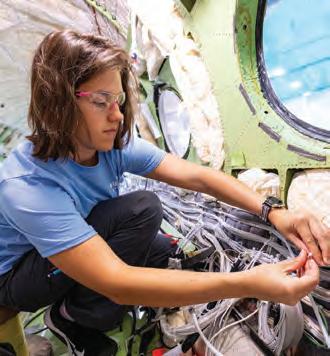
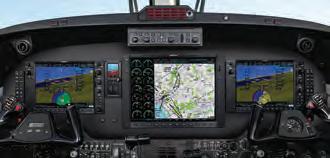





Duncan Aviation is an authorized dealer for most major flight deck and cabin avionics equipment. Our avionics and engineering expertise, combined with our strong relationships with manufacturers, have established Duncan Aviation as the premier provider of avionics systems for business aircraft.
BY JESSICA REED

Pilatus v-p of research and development Bruno Cervia will be proposed for election as a new member of the board of directors at the company’s annual general meeting next year. Cervia, who joined the company as an aerodynamics engineer in 1986, has overseen the research and development unit since 2009 as deputy CEO. Igor Medici will take over as v-p of engineering on Jan. 1. He has been with Pilatus since 2009 and manages a team focused on new aircraft development. Meanwhile, Ioannis Papachristofilou, v-p of government aviation, will take over as deputy CEO at the start of next year.
Citadel Completions named Gregory Colgan as CEO. Colgan’s 25-plus years of aviation industry experience include serving as the CEO of MRO Holdings.
João Mellão moved from the position of COO to CEO at Amaro Aviation in August. The previous CEO, Marcos Amaro, took on the role of chairman.
Aspen Avionics named Daniel O’Donnell senior v-p and general manager. O’Donnell, a member of the company’s board of directors since 2018, previously consulted for private equity, airlines, and OEMs and had served as JetBlue’s director of fleet strategy and aircraft programs. John Uczekaj, previously Aspen Avionics’ senior v-p and general manager, is now president and COO of Aspen parent company Airo Group Holdings.

Go Rentals , a car rental provider serving private aviation clients, appointed Shawn O’Brien as COO and Martin Elliott as CFO to support business expansion. O’Brien joins Go Rentals after more than a decade at management consulting firm Bain & Company. He previously served as a strategic advisor to Go Rentals for two years, contributing to revenue management system development. Elliott arrives from his position as CFO at global apparel brand Spanx.
Chris Salley was selected as the next president of FBO Partners. He has been with the company for more than five years. Douglas Wilson is
stepping down after 12 years in his role as president. Wilson will join the FBO division of Clay Lacy Aviation as chief business officer.
Gregg Evjen became president of KF Aerospace on September 1. Previous president and CEO Tracy Medve shifted to CEO of umbrella company KF Capital. Evjen has been part of KF Aerospace since joining as a junior engineer in 1989 and has led hundreds of regulatory approvals and engineering projects.
Retired U.S. Air Force general Mike Minihan has joined Gogo’s board of directors. His military career spanned 34 years, including serving as Air Mobility Command commander, and he is a senior advisor for several companies, including Reliable Robotics and Beta Technologies.

Jack Levandowski joined Thales as sales manager with a focus on selling aircraft satcom, audio/ radio management, antenna, and external/internal lighting systems to OEMs and MROs. He previously worked with multiple companies supporting Part 121, 91, and 135 operators’ scheduled maintenance and avionics requirements.
Eric Hein is now director of strategy and product development at Wichita State University’s National Institute for Aviation Research (NIAR). Hein previously served as v-p of defense programs at Spirit AeroSystems and earlier worked at Cessna and Boeing in engineering roles.

Wichita State University’s W. Frank Barton School of Business chose Maggie Topping as the J. Robert Young Executive-in-Residence for the fall 2025 semester. Topping is Textron Aviation’s senior v-p of human resources and communications and is also an alumna of WSU.
MaKayla Gorski was hired as v-p of sales for managed aircraft at business aircraft charter, fractional, management, and maintenance provider Airshare. Gorski previously was the director of aircraft management at Sun Air Jets.
Air Charter Service appointed Kerry Holder to the position of CFO, effective August 1. Holder’s
career began in 1997 at KPMG, and her two most recent roles involved serving as finance director for large companies.

George J. Priester Aviation promoted Eric Bewersdorf, who joined the company last year, to v-p of maintenance. Bewersdorf’s OEM experience spans 25 years, and he previously coordinated maintenance and delivery for a large Part 135 fleet. Additionally, the company hired Alan Harman as director of maintenance and Alexandra Guras as national director of flight services. Before joining Priester Aviation, Harman maintained a 75-aircraft fleet for a Part 135 operator and worked for a regional private aviation provider. Guras’ background includes aircraft management and dispatch operations, and she has managed performance, compliance, and service delivery while overseeing air medical bases.
Chapman Freeborn, part of the Avia Solutions Group, named Vilma Vaitiekunaite v-p of passenger for Saudi Arabia. Vaitiekunaite was CEO of Avia Solutions Group brokerage Skyllence, and was chief communications officer for the group.
Metro Aviation promoted Chad Laviolette to operational control center manager. Laviolette served in the U.S. Army and has more than three decades of military and aviation experience.

Hydrogen-powered uncrewed aerial systems developer Heven named Warren Brown chief marketing officer. Brown’s more than 30 years of experience includes senior marketing roles at Boeing, SAIC, Iridium Satellite, iDirect Technologies, Deltek, and Fortem Technologies.
Alud Davies, media and publications director of Asian Sky Group, was named to the board of governors for the Asian Business Aviation Association. Davies’ experience in research and journalism within the aviation industry spans more than two decades.
Robert Woods was hired as general manager of Appleton International Airport’s Appleton Flight Center. He brings more than two decades of airline experience and previously served as a licensed air traffic controller and instructor for the U.S. Marine Corps. z
Longtime corporate pilot Johnnie Spotts, 97, passed away on July 12 following a 56-year career in aviation. He began flying a DC-3 for Southern Airways in 1951 while living in Memphis, and transitioned into corporate aviation in 1960. Spotts served as captain and chief pilot for Pitts Oil, Winnebago, and Penn Corp Financial. Notably, he was Frank Sinatra’s chief pilot for almost three decades. During his career, Spotts also flew Elvis Presley, Ronald Reagan, Bob Hope, and a young Harrison Ford. Later, he served as captain, chief pilot, and training director at Clay Lacy Aviation, retiring in 1998 as training director for The Air Group.
Retired NASA astronaut, U.S. Navy pilot, and industry advocate James “Jim” Lovell Jr., 97, passed away on August 7. Lovell commanded the Apollo 13 moon mission in April 1970, retiring from NASA the following year. He stood against the privatization of the U.S. air tra c control system, expressing concerns on behalf of NBAA in a video along with Lloyd “Fig” Newton, among others.
John King and Martha King were recognized by the Air Command and Sta College for contributions to air, space, and cyberspace. They gave a presentation to graduating U.S. Air Force o cers on leadership and aviation risk management in May at Maxwell Air Force Base in Alabama. Nicolas Chabbert, CEO of Daher Aircraft, received the Golden Pulaski Award from the Recreational Aviation Foundation (RAF) at EAA AirVenture 2025.
The National Aeronautic Association announced seven honorees as the 2025 Wesley L. McDonald Distinguished Statesmen and Stateswomen of Aviation. Lisa Anderson Spencer is honored for promoting aviation careers and safety. Nia Gilliam was awarded for her lifelong commitment to broadening the talent pool for the industry. Rebecca “Becky” Lutte is recognized for contributing to education, safety, and policy. Mike McGowan was awarded for advancement of skydiving and skill in aerial photography. Former NTSB chair Robert Sumwalt III is honored for contributions to safety. Barbara Walters-Phillips was honored as an educator, pilot, mentor, and community advocate, and Holly Woodru Lyons was honored for advancing aviation policy and contributing to aviation law as a congressional sta er.
There’s an expectation for heightened support. You have those C-level folks or those very high-net-worth individuals flying in these jets, and when something happens— and things do happen—what is the level of support?
It’s a combination. You will have a market that is growing, but at the same time consolidating in terms of who’s delivering service. Success will come from those who are close to the ecosystem, who are developing solutions that meet the customer’s expectations in a simple, frictionless way, and at the same time, you have the whole ecosystem behind it to support it. Whoever can deliver on all those things at the same time will have a place here.
MICHAEL SCHRAGE I just want to offer [a few] insights that I’m coming away with from this conversation. The first is the indifference curve. What I’m hearing is that the indifference curve between software versus hardware is going to become more important. If Jay can buy another year of delay by doing firmware or software upgrades with the equipment, that’s probably worth a lot to him in terms of scheduling maintenance, replacement, et cetera. One of the outstanding questions is, where is software not just a good substitute but a better substitute than the core hardware in this regard? In terms of customer experience, I see two things going on related directly to terrestrial versus up in the air, and that is the whole notion of a handoff for onboarding. In the same way the flight attendant gets your meal in advance, they are going to get your bandwidth menu or your compute menu in advance, or there will be a button that you hit on your iPhone or your Android, and it will send a signal to the router, to the intelligence unit in the plane. And that is going to do a more intelligent job of bandwidth allocation, capacity allocation. I don’t think you’re going to have a bandwidth [split] between the front of the plane and the back of the plane. I think more intelligent allocation of resources is going to be a really interesting challenge and opportunity. z

JAMES HOLAHAN (1921-2015), FOUNDING EDITOR, WILSON S. LEACH, FOUNDER & CHAIR EMERITUS
EDITOR-IN-CHIEF – Matt Thurber
MANAGING EDITOR – Charles Alcock
DIGITAL EDITOR – Chad Trautvetter
EDITOR AIN MONTHLY MAGAZINE – Kerry Lynch
BUSINESS AVIATION SERVICES EDITOR – Curt Epstein
SENIOR EDITOR – Hanneke Weitering – Technology Editor
COPY EDITOR – Jessica Reed
NEWS REPORTER – Amy Wilder
CONTRIBUTORS – Charlotte Bailey – Europe, David Donald – UK, Jennifer Leach English, David Jack Kenny – Safety, Gordon Gilbert, Jennifer Meszaros – Southeast Asia, Dale Smith, Richard Pedicini, James Wynbrandt
PRODUCTION MANAGER – Martha Jercinovich
GRAPHIC DESIGNER – Grzegorz Rzekos
DIRECTOR OF VIDEO – Ian Whelan
SENIOR DEVELOPER – Cameron MacPherson
FRONT END DEVELOPER – David Lohmeyer
EXECUTIVE CHAIR – Dave Leach
PRESIDENT – Ruben Kempeneer
HEAD OF PEOPLE & BRAND – Jennifer Leach English
SENIOR DIRECTOR, INDUSTRY AFFAIRS AND EVENTS – Nancy O’Brien
ADVERTISING SALES
DIRECTOR OF SALES - Henry Specht
Victoria Tod – Northeastern U.S./Eastern Canada/United Kingdom, +1 (203) 733-4184
Michelle James – Western U.S./Western Canada, +1 (520) 343-0236
Joe Rosone – Midwestern U.S., Southeastern U.S./Caribbean/Brazil, +1 (301) 693-4687
Diana Scogna – Europe/Middle East, +33 6 62 52 25 47
DIRECTOR OF MARKETING AND CLIENT SERVICES – Lisa Valladares
AUDIENCE DEVELOPMENT DIRECTOR – Eileen Silberfeld
EVENTS SPECIALIST – Brien O’Brien
MARKETING SPECIALIST – Alyssa Barry
SOCIAL MEDIA MARKETING – Zach O’Brien
SALES ADMINISTRATOR – Cindy Nesline
MANAGER OF FINANCE & HUMAN RESOURCES – Tracy Britton
ACCOUNTS PAYABLE – Mary Avella
ACCOUNTS RECEIVABLE – Bobbie Bing
U.S. HEADQUARTERS
214 Franklin Ave., Midland Park, NJ 07432, +1 (201) 444-5075
Advertising Inquiries: +1 (201) 345-0085, adsales@ainonline.com
Circulation Inquiries: +1 (201) 345-0085, subscriptions@ainonline.com
WASHINGTON, D.C. EDITORIAL OFFICE: Kerry Lynch: klynch@ainonline.com, Tel: +1 (703) 969-9195
EUROPEAN EDITORIAL OFFICE: Charles Alcock: calcock@ainonline.com, Tel: +44 7799 907595
Aviation International News (ISSN 0887-9877) is published twelve times per year (monthly). Periodicals postage paid at Midland Park, N.J., and additional mailing o ces. Postmaster: Send address changes to AIN Media Group, 214 Franklin Ave., Midland Park, NJ 07432. Allow at least eight weeks for processing. Include old address as well as new, and an address label from a recent issue if possible.
Subscription inquiries: +1 (201) 345-0085 or email: subscriptions@ainonline.com.
Aviation International News is a publication of AIN Media Group, 214 Franklin Ave., Midland Park, NJ 07432; Tel.: +1 (201) 444-5075.
Copyright © 2025 All rights reserved. Reproduction in whole or in part without permission of AIN Media Group is strictly prohibited. AIN Media Group publishes Aviation International News, AINalerts, AINonline, Business Jet Traveler, BJTwaypoints, ABACE Convention News, Dubai Airshow News, EBACE Convention News, Farnborough Airshow News, FutureFlight.aero, VAI Convention News, LABACE Convention News, MEBAA Convention News, NBAA Convention News, Paris Airshow News, Singapore Airshow News, Mobile Apps: Aviation International News; AINonline. PUBLICATION MAIL AGREEMENT NO. 40649046 RETURN UNDELIVERABLE CANADIAN ADDRESSES TO: PITNEY BOWES INTERNATIONAL MAIL, STATION A, P.O. BOX 54, WINDSOR, ON, N9A 6J5, returns il@imex.pb.com.
For feedback, letters to the editor, or other editorial needs, please contact AIN’s Editors at ainedit@ainonline.com
Save time and money by monitoring the value of your aircraft in 'real-time'.
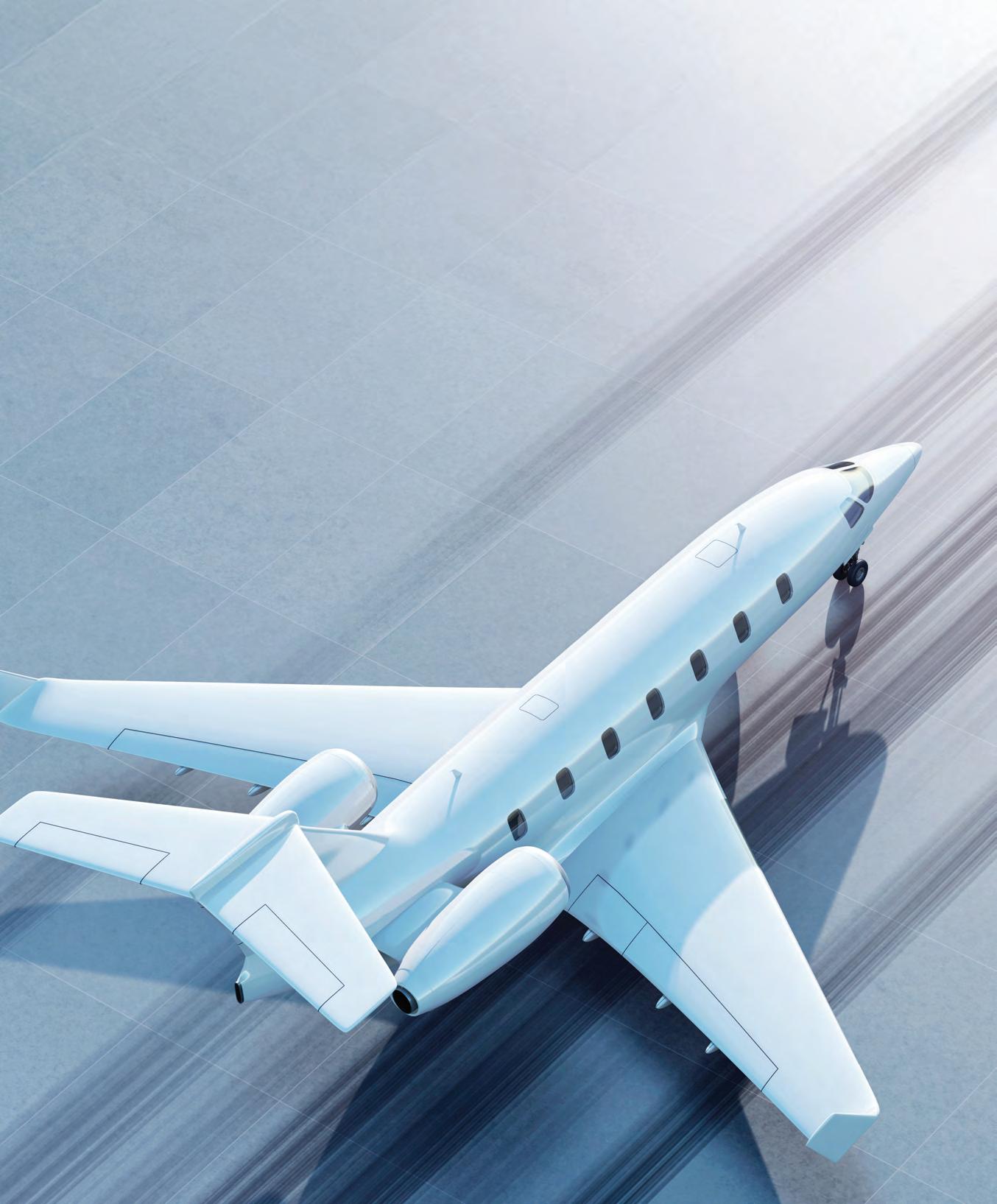
Subscribers can also:
– Generate a comprehensive list of all aircraft transactions in the last 12 months
– View a detailed photo gallery for your specific aircraft
– Receive a weekly report summarizing market fluctuations


With three market-leading businesses, world-class operations and investments in research and development, we offer capabilities no one else can. Together, our global team pushes the boundaries of known science—and finds new ways to connect and protect our world.
Learn more at rtx.com









With three market-leading businesses, world-class operations and investments in research and development, we offer capabilities no one else can. Together, our global team pushes the boundaries of known science—and finds new ways to connect and protect our world.
Learn more at rtx.com